| 1 |
Aerva lanata (L.) Juss. ex Schult. |
Amaranthaceae |
A perennial decumbent herb, woody below; stems and braches with
dense woolly, whitish or yellowish, shaggy hairs; leaves simple, alternate, pubescent,
circular to lanceolate-elliptic, rounded to sharp at the apex; flowers silky white, arranged
in a dense spikes, solitary or in clusters; fruits ; seeds bean-shaped
|
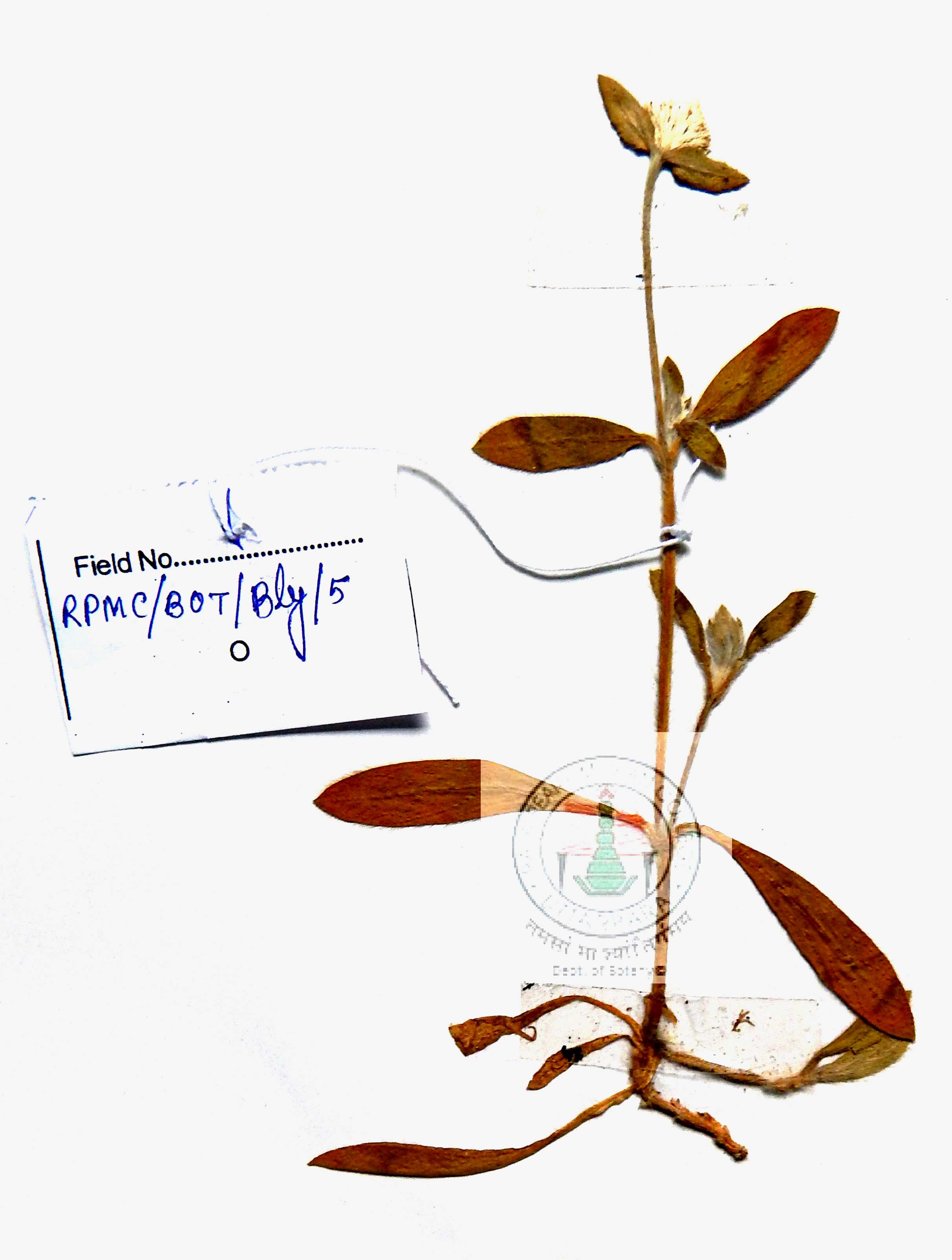
|
| 2 |
Ageratum conyzoides L. |
Asteraceae (Compositae) |
Erect, annual herb, stem hairy, leaves opposite, 30-50 self compatible
pink, white or violet flowers are arranged as a corymbs capitullum inflorescence,
fruit-achene with an aristate pappus & is easily dispersed by wind.
|
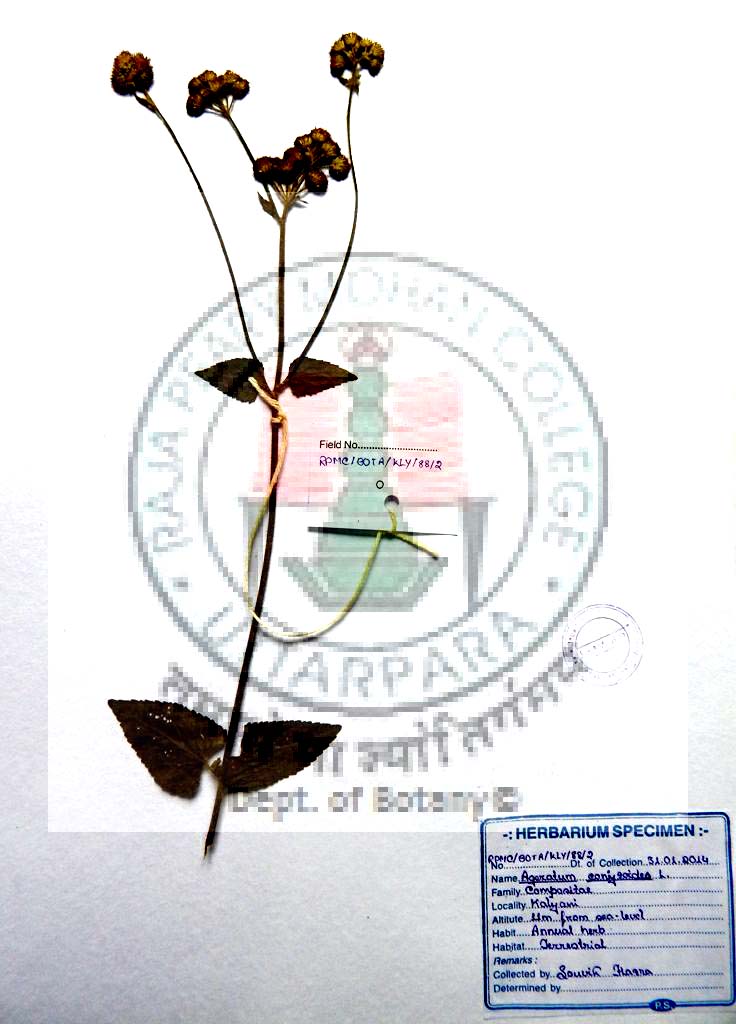
|
| 3 |
Ageratum houstonianum Mill. |
Asteraceae (Compositae) |
An annual branched semi-erect herb; leaves oval to heart-shaped;
flowers purple to blue to lavender or pink, arranged in capitula, ray florets are thread
like; anthers syngenesious; fruits cypsela with pappus
|
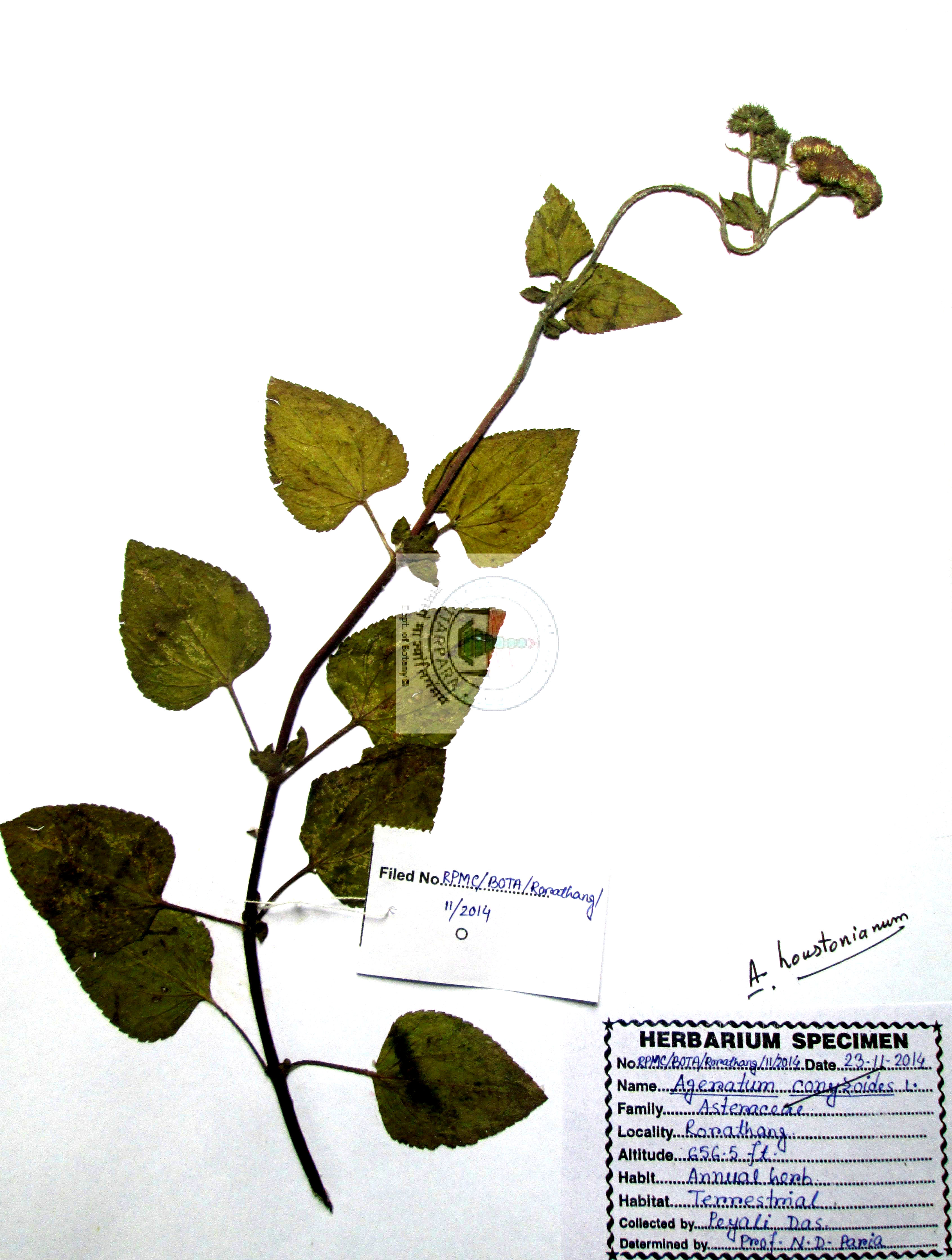
|
| 4 |
Alternanthera sessilis R.Br. ex DC. |
Amaranthaceae |
Perennial much branched prostrate herb; stems prostrate, rarely
ascending; leaves simple, opposite, somewhat fleshy, obovate to broadly elliptic,
occasionally linear-lanceolate, glabrous to sparsely villous, shortly petiolate; flowers in
sessile spikes, bract and bracteolate, shiny white, glabrous; flowers are situated over the
stem with shape as round; sepals equal, outer ones mono-nerved or indistinctly
3-nerved toward base; stamens 5, sterile; fruits obcordate utricles.
|
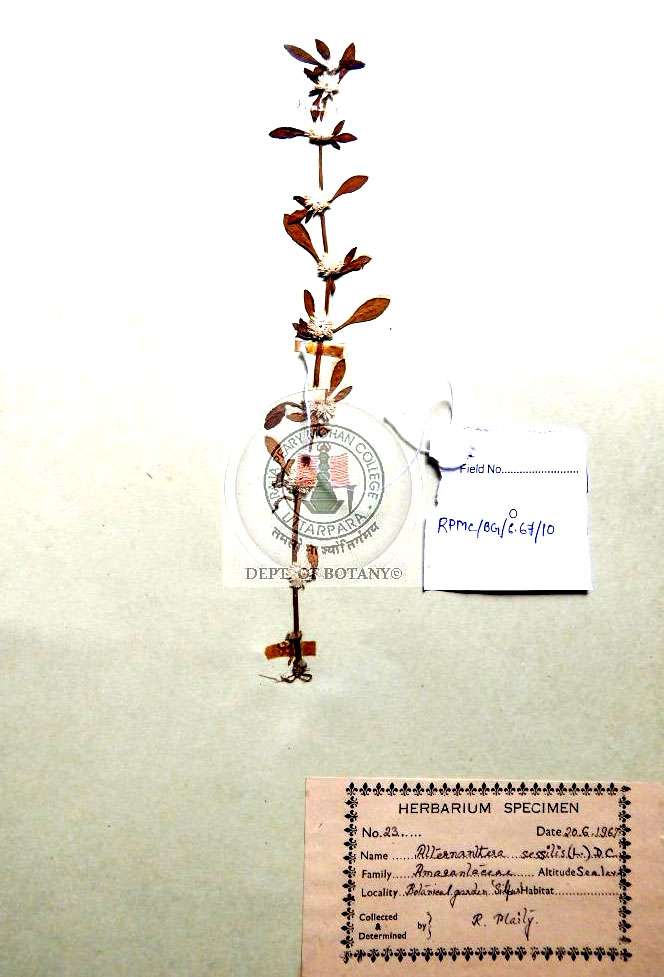
|
| 5 |
Anaphalis contorta (D.Don) Hook.f |
Asteraceae |
Small herb,erect perennial stem usually branched with dense white woolly,
leaves crowded at the base,narrowly liner or oblong,pointed,flowers are densely
crowded corymbs,tiny yellow florets are surrounded by shiny white bracts.
|
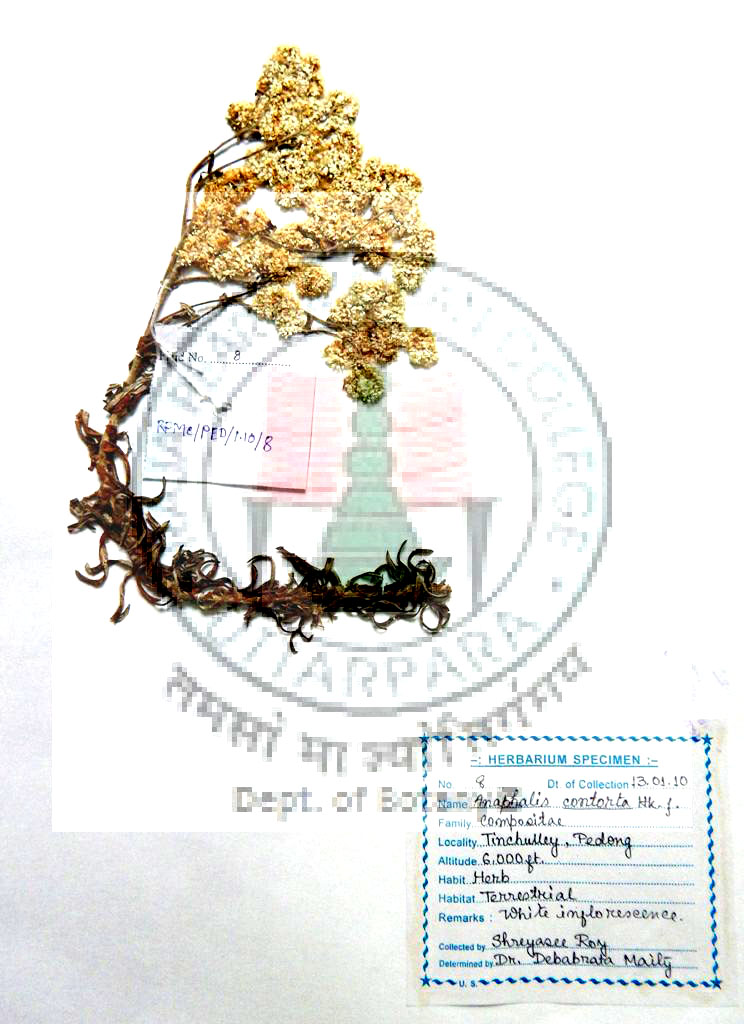
|
| 6 |
Antigonon leptopus Hook. & Arn. |
Polygonaceae |
Perennial fast growing evergreen vine; stems climbing with tendril reaching up to
40 ft, pentagonal, with many lateral branches; leaves dark-green, alternate, caudate to sagittate,
without ochreate stipule, acute or acuminate at apex, cordiform or truncate at base, crenulate at
margins; flowers many, tiny, sepals larger than corolla, delicately pink to deep coral, giving the
characteristic color, flowers arranged in axillary racemes or terminal panicles, 10-20 cm long,
terminating in a pair of spiral tendrils; perianth 4-7 mm long, of 5 ovate or elliptical tepals,
intense pink or white; staminal column 2-3 mm long, of the same color as the tepals;
placentation basal; fruit-a 3-angled achene
|
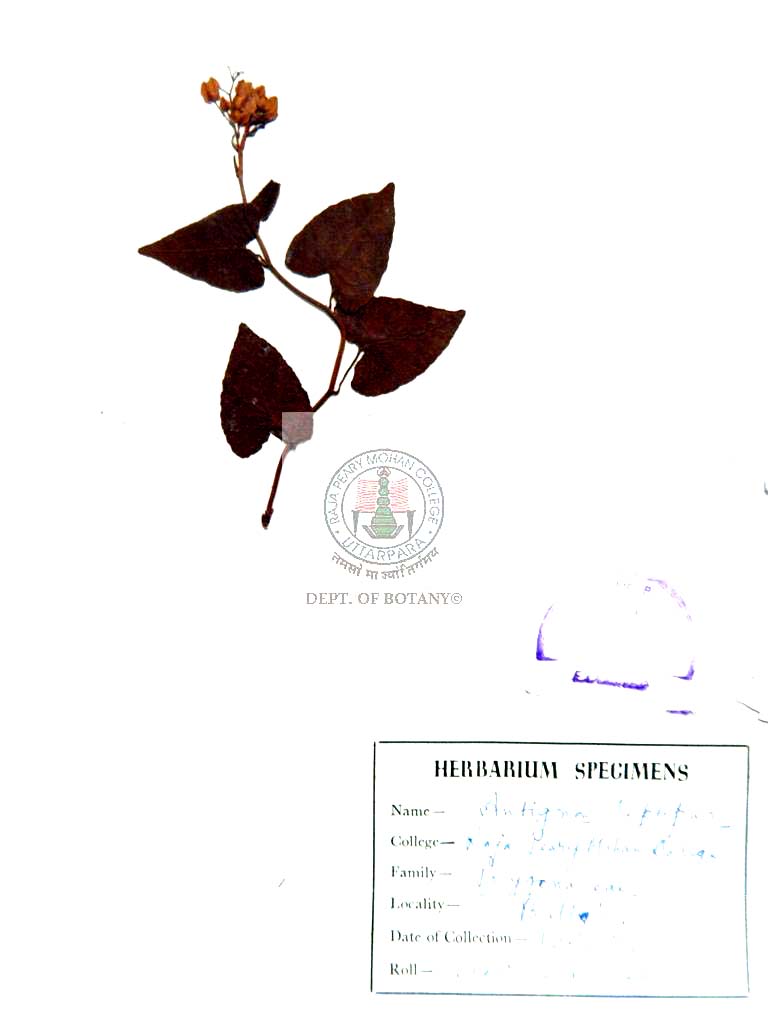
|
| 7 |
Argemone mexicana L. |
Papaveraceae |
An annual prickly branched herb with yellow juice; leaves thistlelike,
alternate, clasping with stem, oblong, multiple cut, shiny, pale bluish-green and exudes
an unpleasant-smelling yellow sap when cut; with acute spine like at apex, while in vein,
deeply lobed with irregularly toothed, spiny margins; flowers yellow, solitary, subtended
by 1-2 leafy bracts; sepals 3, prickly; petals 4-6, yellow to pale orange, glabrous;
stamens numerous; fruits capsule; seeds dark brownish black colored, numerous,
globose and netted
|
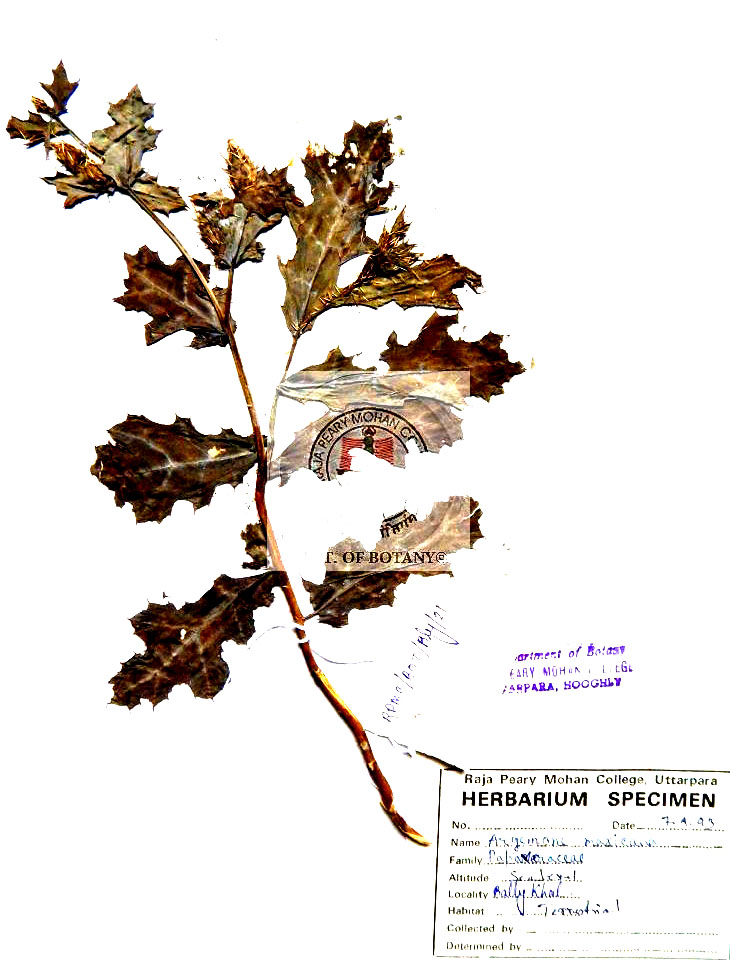
|
| 8 |
Bidens pilosa L. |
Asteraceae (Compositae) |
Erect, annual, almost glabrous to densely hairy woody herb with angular branches
and characteristic dark green colour; leaves are opposite and are divided pinnately into 3-5
leaflets with toothed margins, leaflets ovate to lanceolate; marginally winged petiole; flowers
white and yellow and 5-15mm in diameter, borne on long slender peduncles, each flower head
has 4 or 5 short, broad, white petals (ray florets) with numerous, yellow disc florets. The outer
involucral bracts have finely hairy margins and are shorter than the inner bracts; anthers
syngenesious. Fruit cypsela, slightly curved, stiff, heavily barbed awns at the distal ends.
|
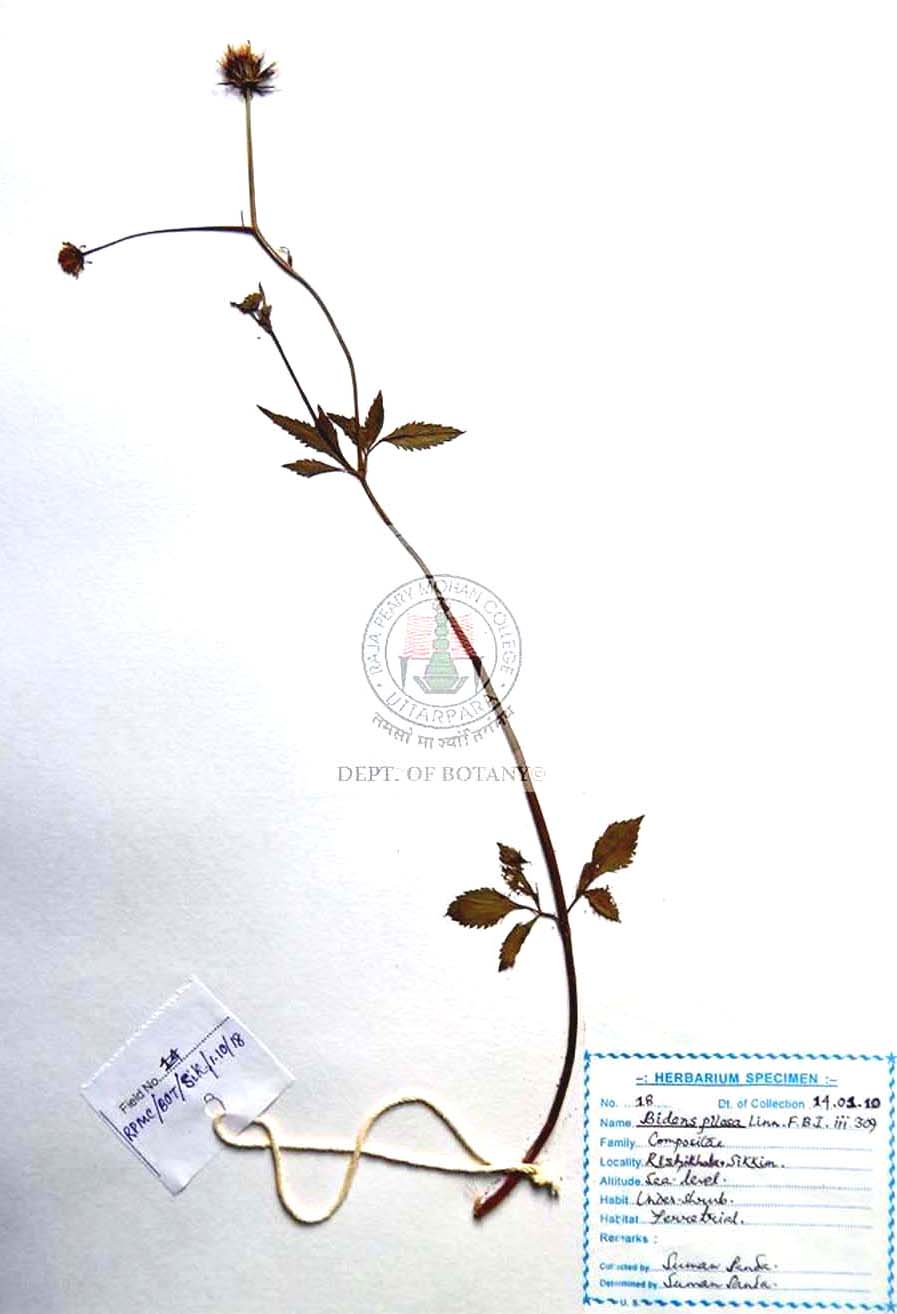
|
| 9 |
Blumea lacera (Burm.f.)DC |
Asteraceae |
Annual,erect herb with a strong odor, stems hairy or glandular ,simple or
branched, very leafy, leaves obovate or oblanceolate, smaller toward the top, stalked,
and toothed or (rarely) lobulated at the margins; the bright yellow flowering heads, borne
on short axillary cymes, and collected in terminal, spike-like panicles; the
involucre-bracts are narrow and hairy; Fruit is an achene, oblong and not ribbed ,Pappus
is white;
|
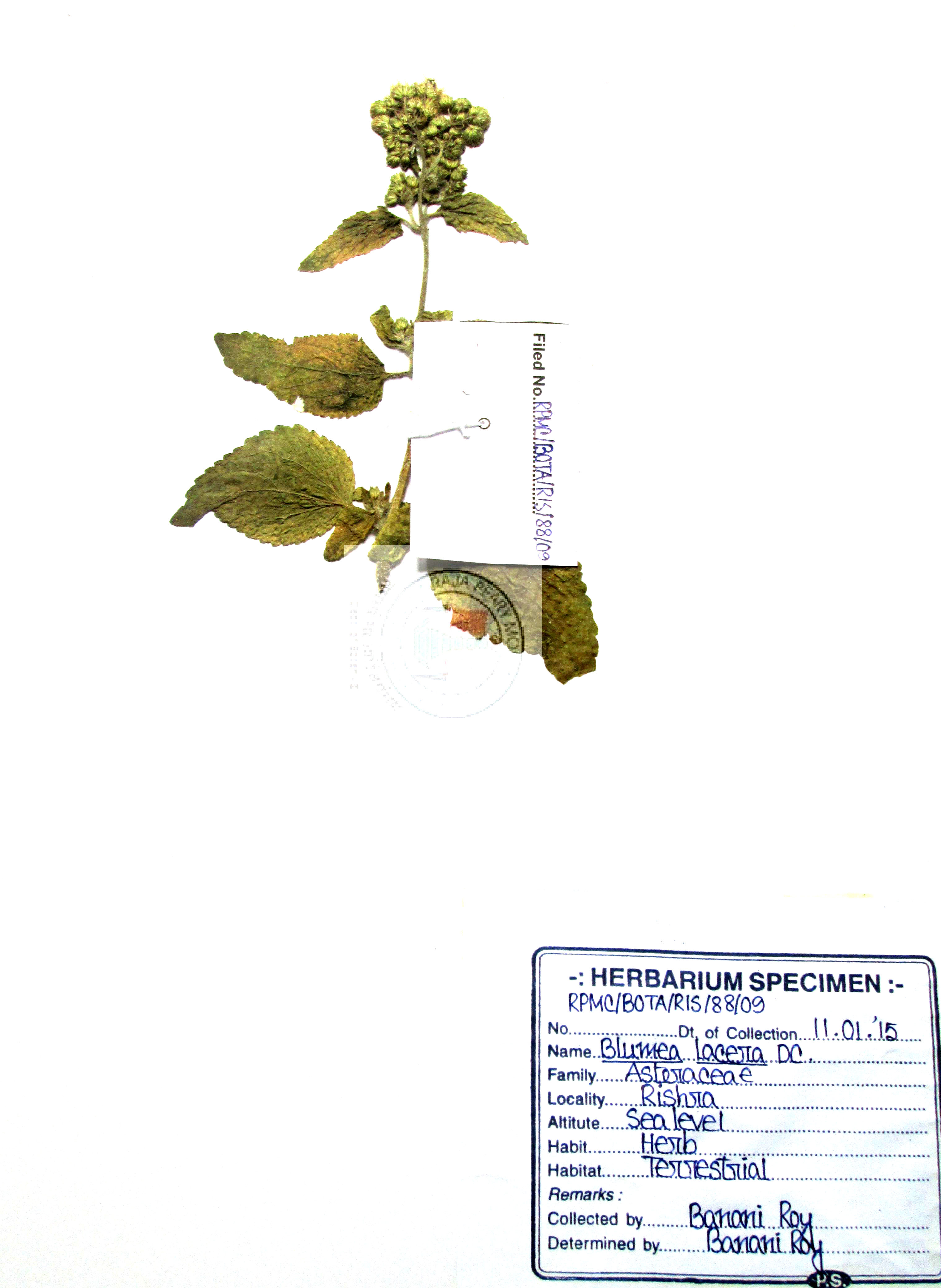
|
| 10 |
Cassia alata L. |
Fabaceae-Caesalpinioideae (Leguminosae) |
Evergreen tropical shrub or tree, typically grows to 12-30’ tall; leaves
pinnately compound, dark-green, each with 7-14 pairs of leaflets; leaflets oblong, bright
yellow 5-petaled cup-shaped flowers bloom bottom to top arranged in erect axillary
racemes, the longest petal-standard and the other petals are similar to each other. The
sepals are waxy and smooth to the touch; fruits pods, winged bean-shaped, seeds
quadrangular, flattened, shiny
|
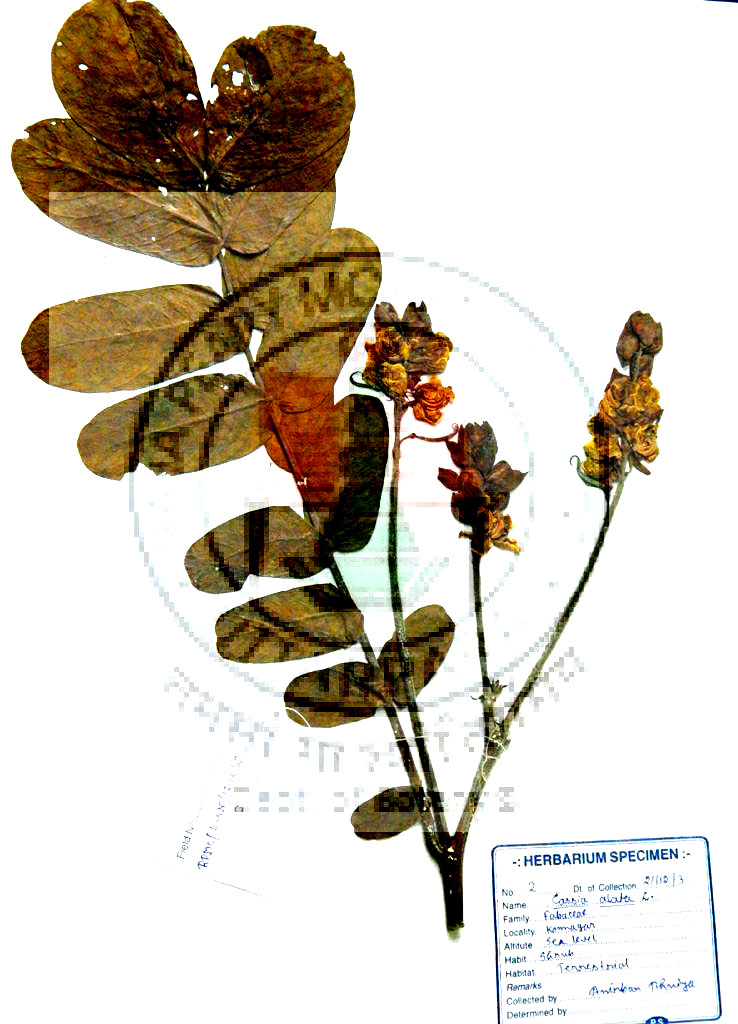
|
| 11 |
Circaea alpina L. |
Onagraceae |
Perennial herb with runners 10-30 cm tall; stem unbranched, fragile;
leaves simple, opposite, acute at apex, cordate at base, toothed at margin, no stipules;
flowers white, regular, bracteate, radially symmetrical, arranged In a lax raceme, has
hypanthium; both sepals and petals 2 each in number, the petals are thin and delicate,
obovate, retuse at apex, and pigmented ; stamens 2, anthers basifixed to filaments,
ovary inferior, carpels 2 fused; fruit dry indehiscent, hairy achene, 1.6-2.6 mm
|
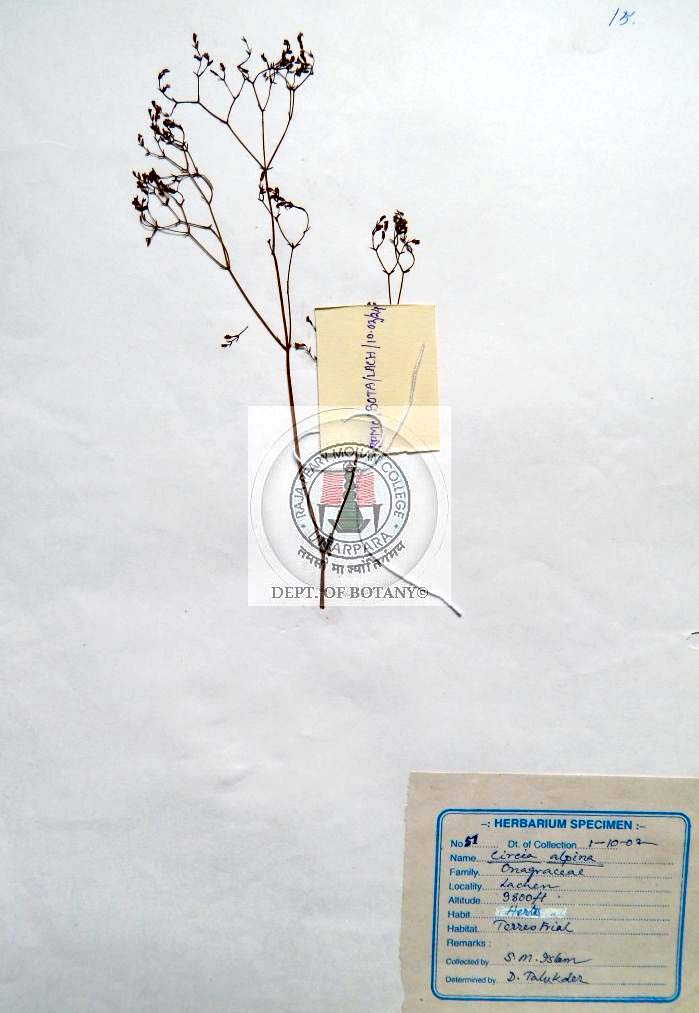
|
| 12 |
Coix lacryma-jobi L. |
Poaceae (Gramineae) |
A tall grain-bearing coarse annual herb/undershrub, attain a height of
1-2m; stems erect, branched, coarse, with brace roots from the lower nodes; leaves
coarse with broad base to cordate, linear-lanceolate, Inflorescence spikelet with flowers
arranged in racemose gramineaceous manner; fruit caryopsis; seeds yellow, purple,
white or brown, shiny. The grass is monoecious with separate male and female flowers
|
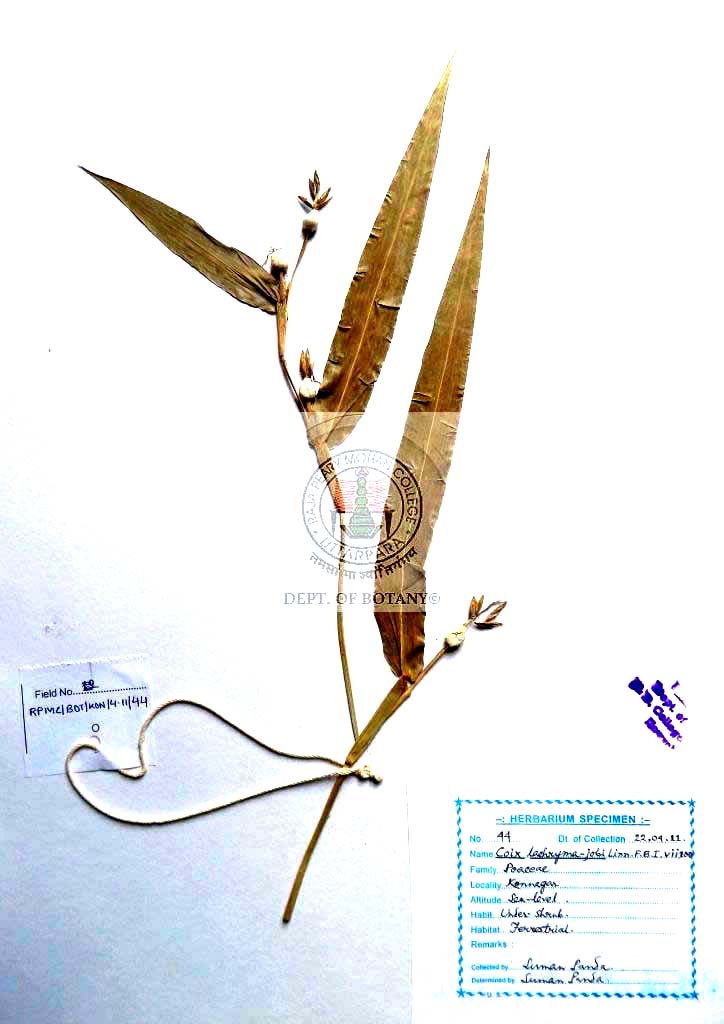
|
| 13 |
Crotalaria incana L. |
Fabaceae (Leguminosae) |
Erect, often bushy shrub; stems hairy; leaves 3-foliolate; leaflets
broad-obovate to broad-elliptic, upper surface glabrous, lower surface sparsely hairy;
stipules filiform; flowers yellow arranged in racemes-10-flowered; pedicellate; bracts and
bracteoles linear; corolla yellowish with reddish brown markings; wings and keel equal;
keel incurved in lower half, beak long, not twisted; placentation marginal; fruit-pod long,
hairy
|
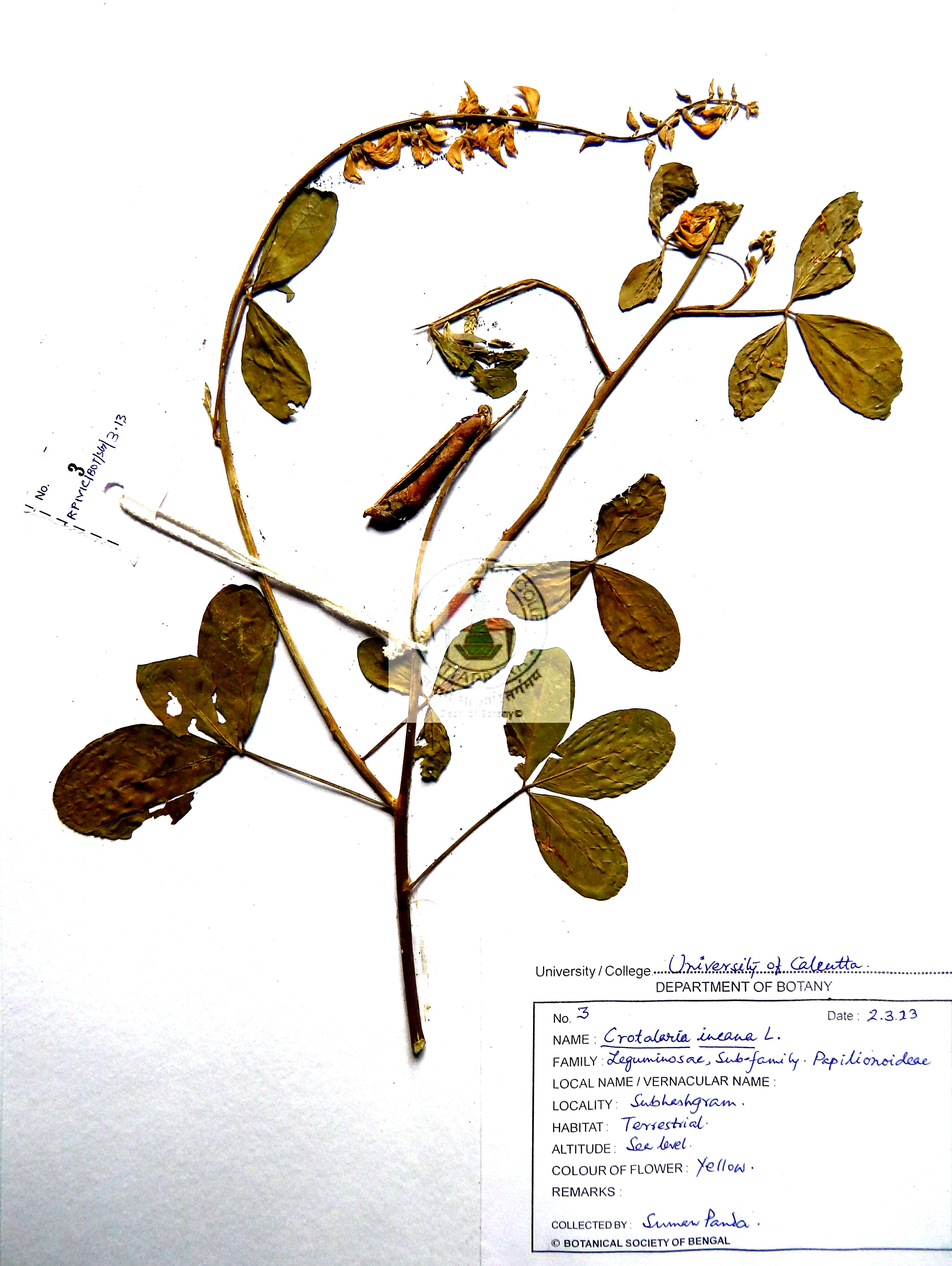
|
| 14 |
Dactyloctenium aegyptium (L) Willd. |
Poaceae (Gramineae) |
slender to moderately robust, spreading annual herb, with wiry stems, that bend and root at the lower nodes, with tips, leaves are typically grass-like, with blades and sheaths that are without hair. Leaf margins have long, stiff hairs, flowers arise in 1-7 spikes, at the tip of stems.; Seed head resembles a crows foot, hence the common name.
|
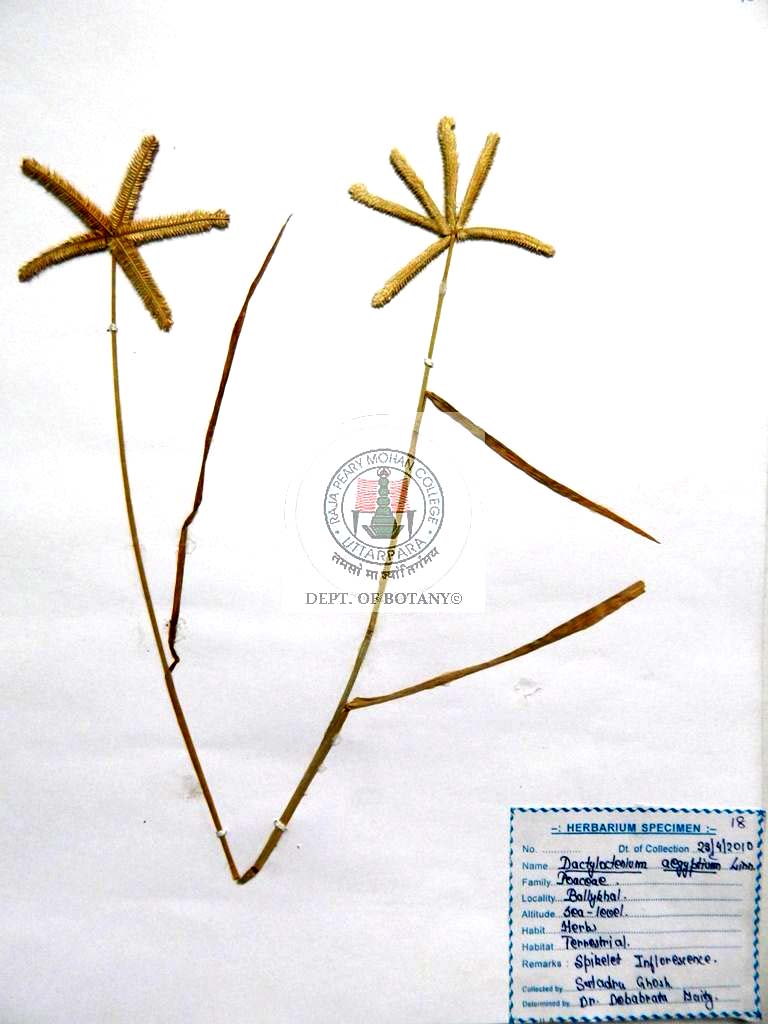
|
| 15 |
Drymaria cordata (L.) Willd. ex Roem. & Schult. |
Caryophyllaceae |
A weak prostrate or creeping annual, or less commonly perennial, herb,
usually with a mass of extensively branched, trailing weak stems; leaves opposite,
round to heart-shaped or oval with rounded bases, rounded or bluntly pointed at tips,
glabrous, weakly three-nerved, and paler below; stipulate; Very short stipules persist at
the bases of the petioles; flowers small consisting of five narrow green sepals, deeply
forked, white petals which are shorter than the sepals, and two or three stamens
surrounding the deeply divided style; arranged in small repeatedly forked terminal or
axillary cymes, on slender, densely hairy pedicels; fruit- a papery capsule, splitting at
maturity into three parts; seeds 5-10 small reddish tuberculate flattened
|
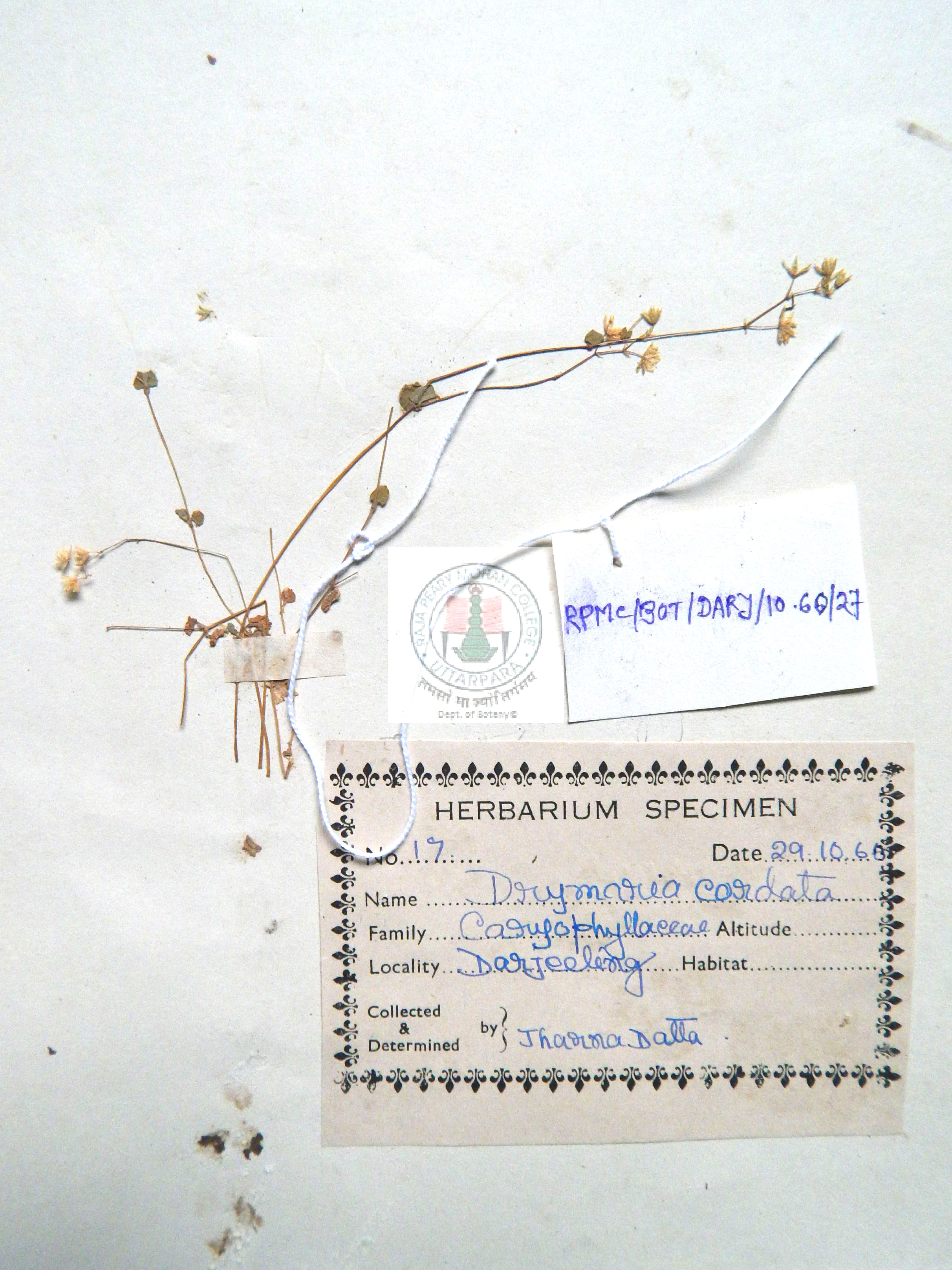
|
| 16 |
Duranta plumieri Jacq. |
Verbenaceae |
Smooth, unarmed shrub, with straggling and drooping branches, small,
obovate-elliptic leaves, pointed or rounded tips and pointed base; Flowers are scentless,
borne on one side of the rachis, white or lilac-blue with two violet stripes in axillary
racemes with terminal panicles, spreading and slender, fruit is fleshy, ovoid,
orange-yellow and 7 to 8 millimeters long.
|
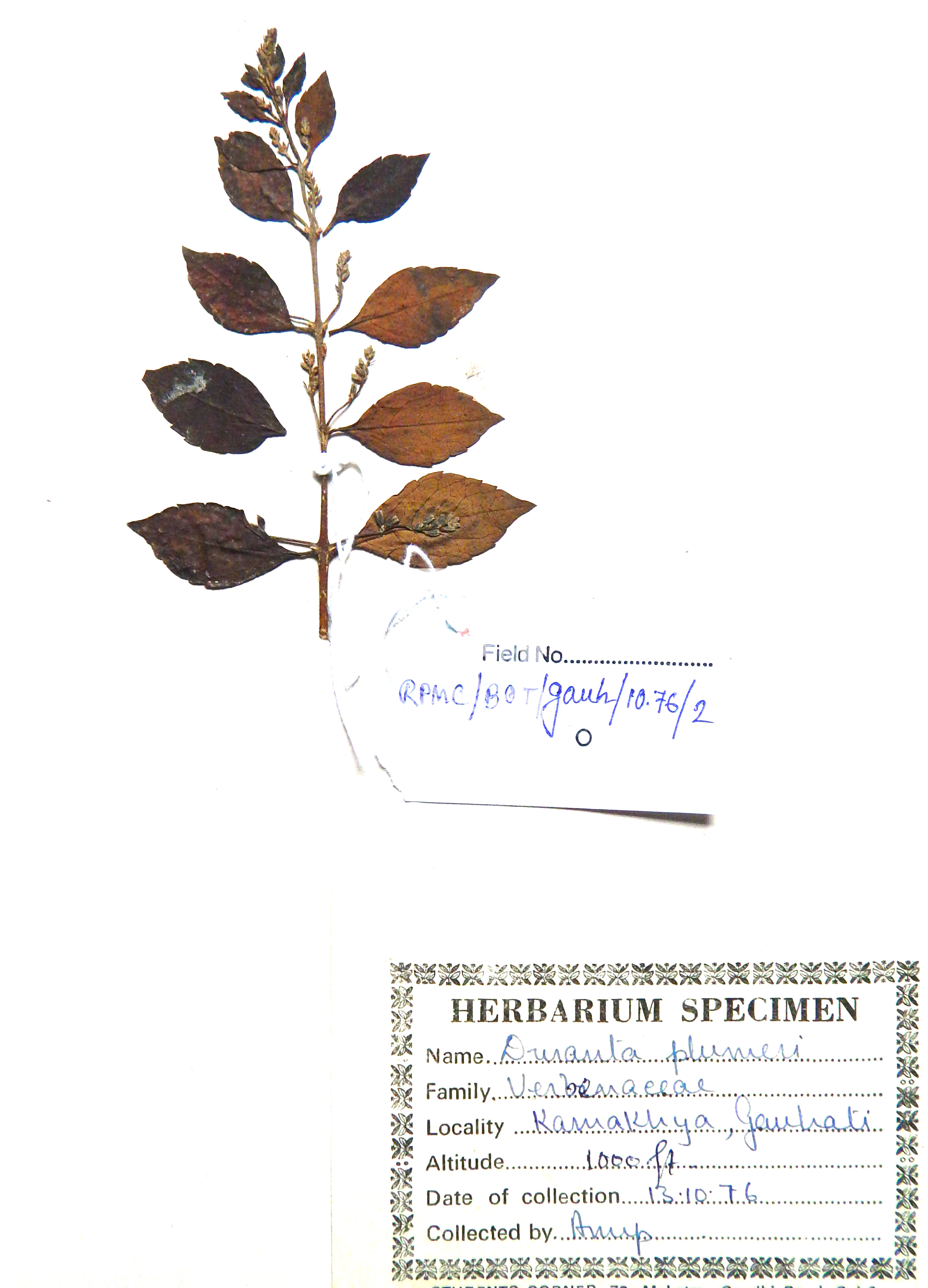
|
| 17 |
Eupatorium odoratum L. (syn. Chromolaena odorata) |
Asteraceae (Compositae) |
Aromatic shrub; covered in fine grey hairs; stems rounded; leaves give off
a pungent, aromatic odour when crushed. The leaves are opposite, triangular to elliptical
blades ovate to diamond shaped, cuminate, with yellow dots below; flowers pale mauve
or violet, tubular flowers are in panicles of 10 to 35 flowers that form at the ends of
branches.
|
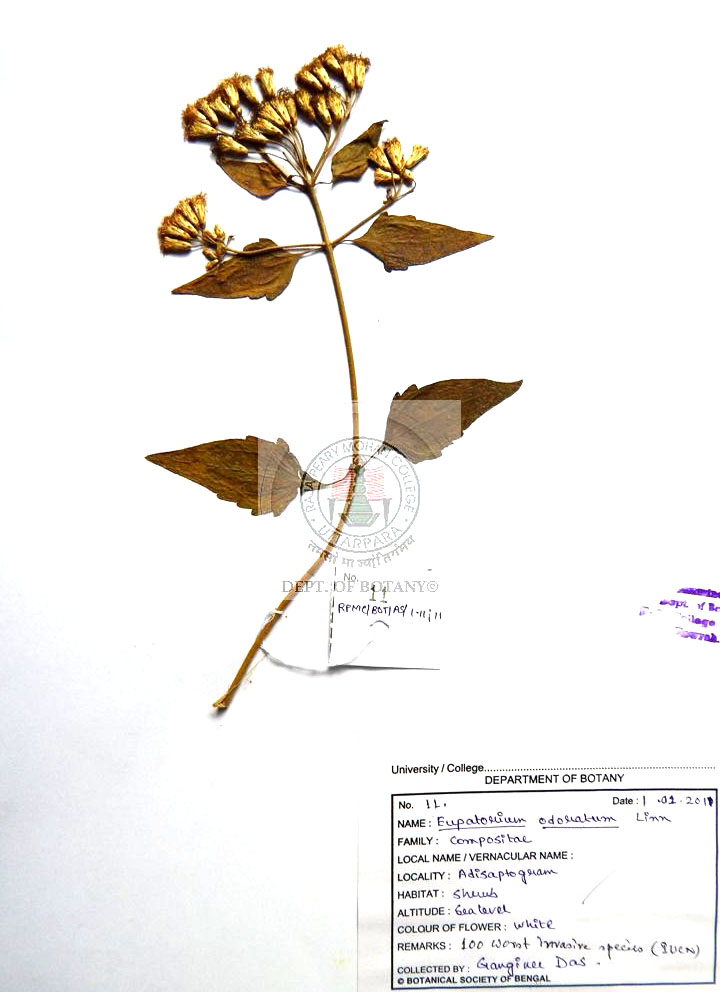
|
| 18 |
Eragrostis tenella Roem& Schult. |
Poaceae (Gramineae) |
Erect, clumped herb, glabrous; Annual; caespitose. Culms
geniculately ascending, or decumbent; 6–50 cm long. Ligule a fringe of hairs. Leafblades
2–9 cm long; 1–3 mm wide. leaves narrow; inflorescence-spike/panicle,
spikelets many flowered, non pedicillate with long silky hairs; fertile
spikelets; spikelets comprising 4–8 fertile florets; with diminished florets at the apex.
Spikelets ovate, or obovate; laterally compressed; 1.5–2.5 mm long; breaking up at
maturity; disarticulating below each fertile floret. Rhachilla internodes definite. outer
glumes shorter than the lowest flowering glume; glumes deciduous; similar; shorter
than spikelet. Lower glume ovate; 0.5–1 mm long; 1 length of upper glume; 1-keeled;
1 -veined. Lower glume lateral veins absent. Lower glume acute at apex. Upper
glume ovate; 1-keeled; 1 -veined. Upper glume lateral veins absent. Upper glume
apex acute; florets; Fertile lemma oblong, or ovate; 0.7–1 mm long; membranous;
keeled; 3 -veined. Lemma midvein without distinctive roughness, or scaberulous.
Lemma apex obtuse. Palea keels ciliate. Apical sterile florets resembling fertile
though underdeveloped fruit a caryopsis with adherent pericarp; ellipsoid
|
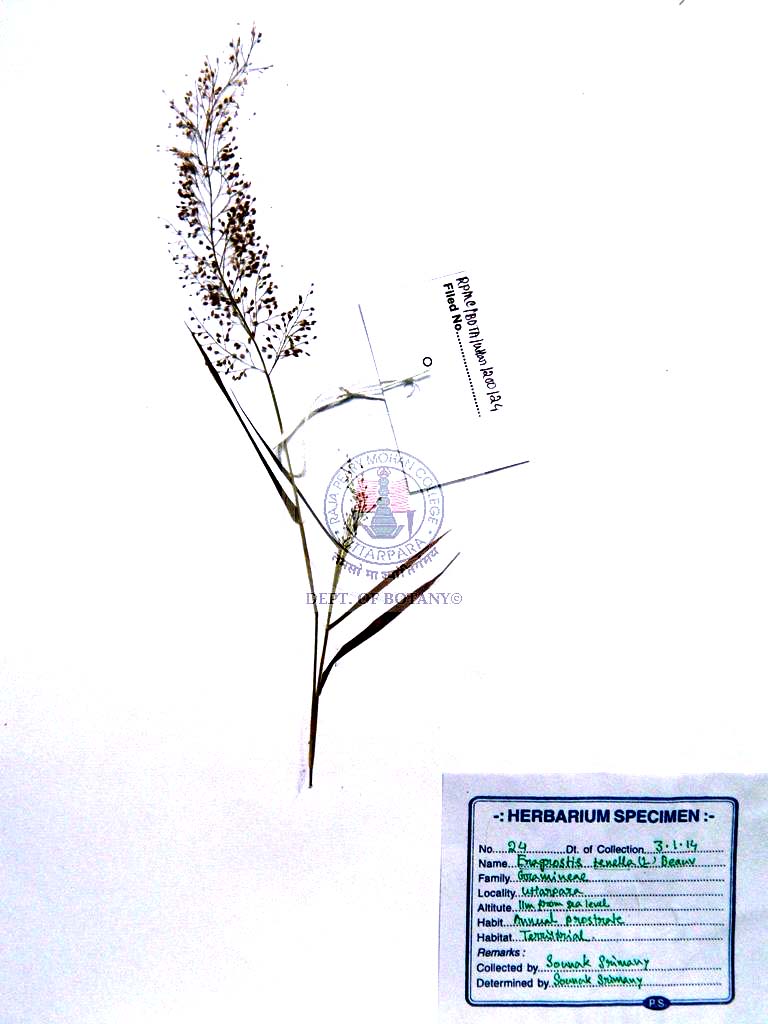
|
| 19 |
Hyptis suaveolens (L.) Poit |
Lamiaceae (Labiatae) |
Rigid annual herb, stem quadrate hairy, leaves either ovate or
obovate. serrulate margins , long stalk, lower surface of the leaves bears hairs; copious
blue flowers in small cymes along branch that ends with reduced leaves. Sepal tube is
hairy in nature, 4 stamens.
|
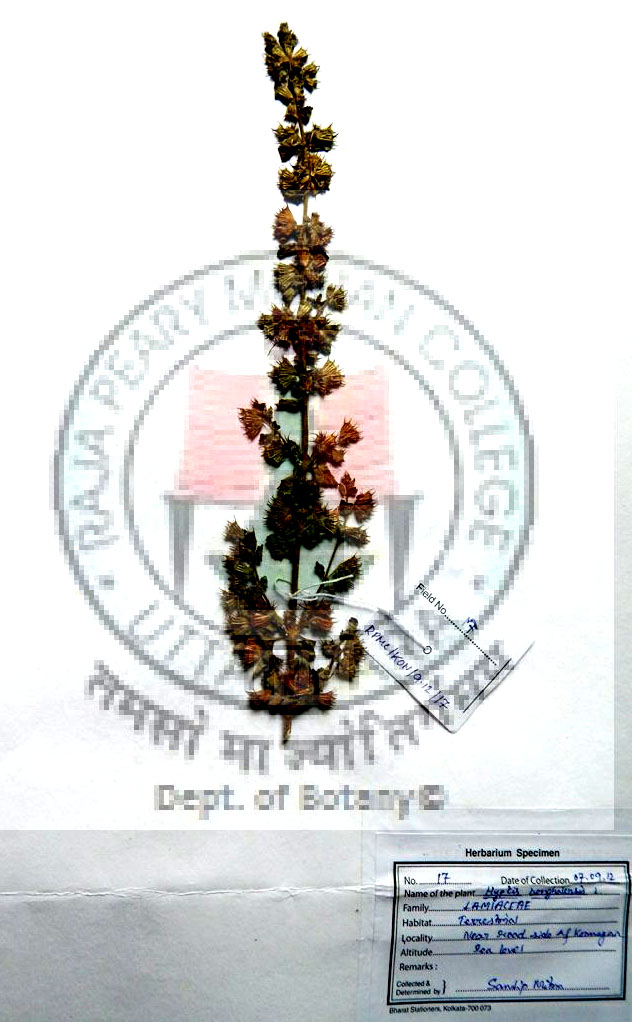
|
| 20 |
Lantana camara L. |
Verbenaceae |
A small perennial shrub which can grow to around 2 m tall and form
dense thickets and recurved spinous hair on stems and branches; leaves serrated,
ovate to ovate-lanceolate; flowers in many ecotypic color- yellow, whitish and pink, later
turning orange then red, arranged in a condensed spike; Fruit is a round, fleshy, 2
seeded drupe, about 5 mm wide, green turning purple then blue-black
|
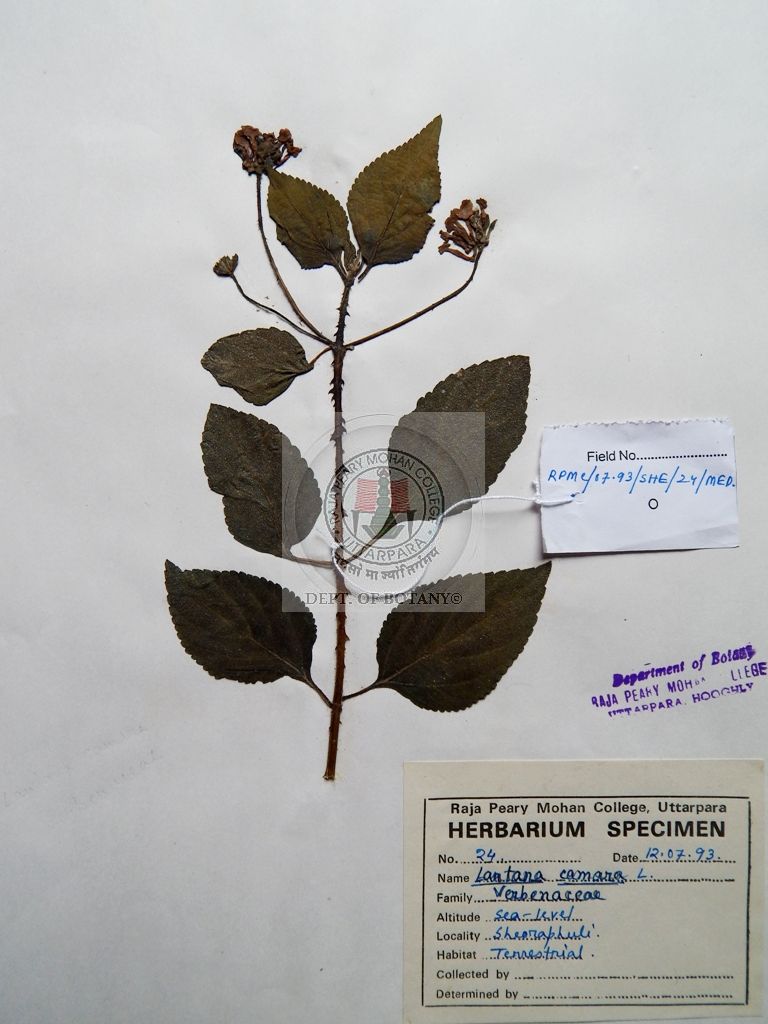
|
| 21 |
Launaea asplenifolia Hook.f. |
Asteraceae (Compositae) |
Annuals or biennials shrubs , sometimes spiny taprooted,Stems erect
distally branched, hairy , Leaves basal blades oblanceolate , often pinnately lobed ,
ultimate margins usually dentate Heads in spiciform or racemiform to paniculiform
arrays].. Florets 25-30; corollas yellow to ochroleucous [cyanic].; pappi persistent or
tardily falling [bristles in 2-3 series white, coarser, barbellulate to smooth bristles in 2-3+
series.
|
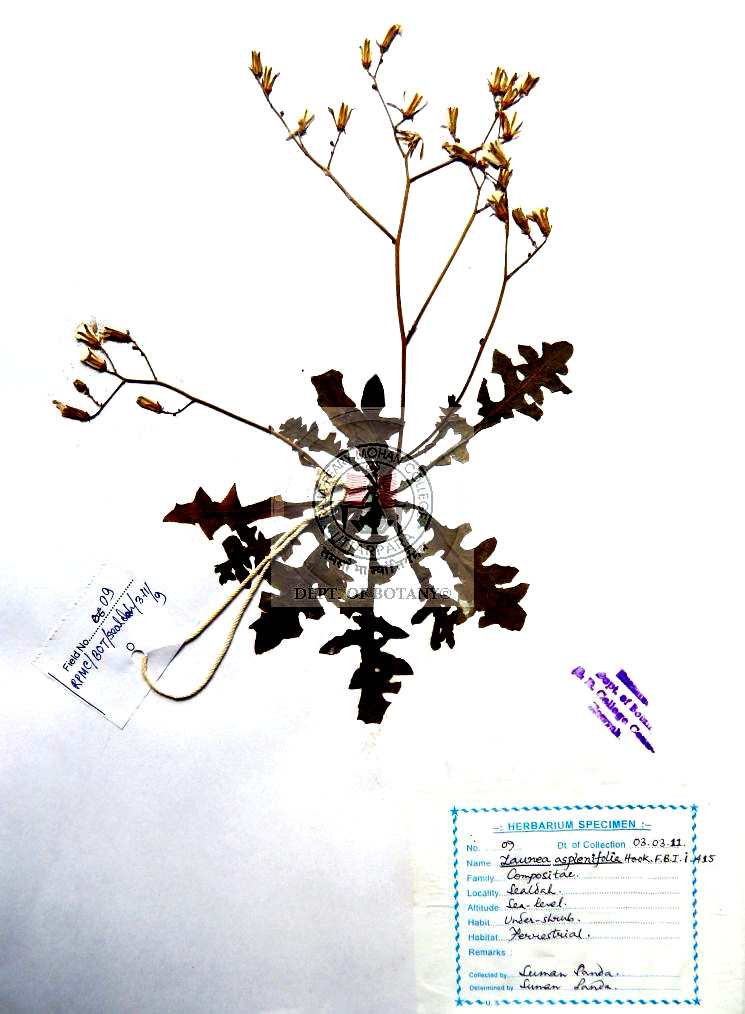
|
| 22 |
Parthenium hysterophorus L. |
Asteraceae (Compositae) |
Erect, annual, much-branched with vigorous growth habit, herb; Shortly after
germination the young plant forms a basal rosette of pale green, pubescent, strongly
dissected, deeply lobed leaves; leaves and stems are covered with short, soft trichomes witn
taxonomic importance; flowers white, composite, flower heads are both terminal and axillary,
pedunculate and slightly hairy, being composed of many florets arranged in rounded
homogamous capitulam, with each head consists of five fertile ray florets (sometimes six,
seven or eight) and about 40 male disc florets; stamens syngenesious; fruit cypsela; seeds
(achenes) black, flattened, each with two thin, straw-coloured, spathulate appendages (sterile
florets) at the apex, acting as air sacs and helps in dispersal.
|
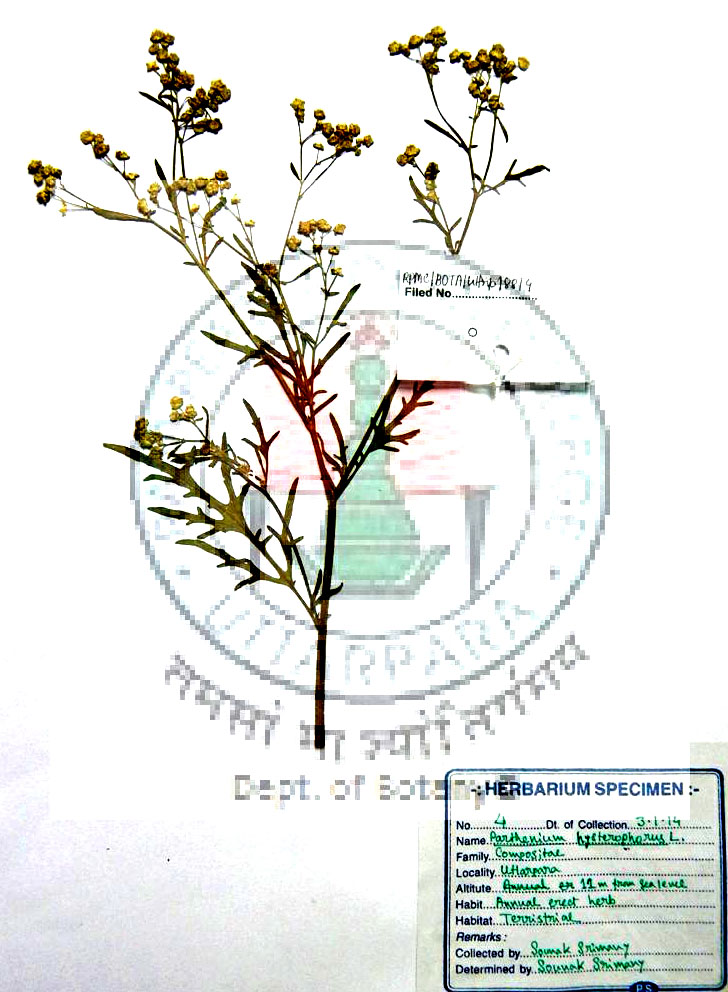
|
| 23 |
Rumex dentatus L. |
Polygonaceae |
Erect, annual herb, unbranched or branched from near the base; basal
leaves are ovate-oblong, ochreate-stipulate, ochrea fugacious, membranous;
inflorescence is a terminal, open, interrupted, branches generally straight,
ascending; flowers are borne in whorls of many flowers, outer tepals are elliptic,
inner ones enlarged in fruit, placentation basal; fruit-achene, a valve, dark red-brown
|
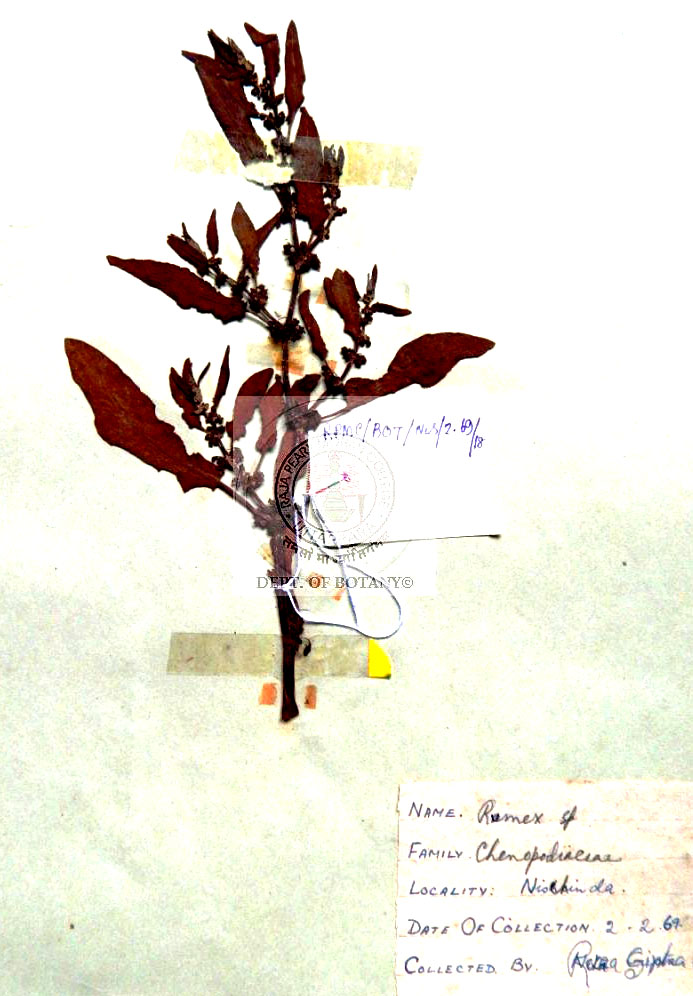
|
| 24 |
Vernonia cinerea (L.) Less. |
Asteraceae (Compositae) |
An annual erect herb; leaves ovate, thinly hair below; corymbose cymes
(homogamous capitulum,pedunculate, flower purple, bisexual, sessile, anthers
syngenesious; fruit achene (cypsela)
|
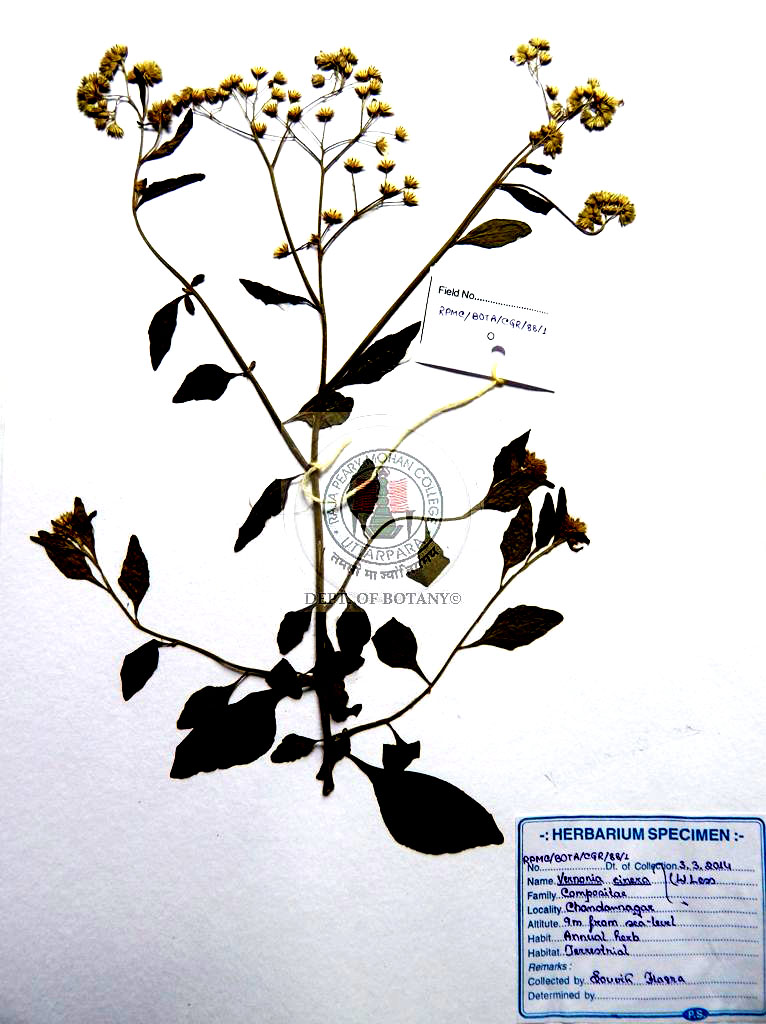
|
| 25 |
Xanthium strumarium L. |
Asteraceae (Compositae) |
It is an annual herb with a short, stout, hairy stem, turn maroon to black
when mature, with an elliptic or egg shaped fruit clusters growing nestled around the
stem. with an elliptic or egg shaped frerrestriauit clusters growing nestled around the
stem, large and broad leaves, light and bright green in color in an alternate pattern with
irregular lobes and relatively inconspicuous teeth, Flower heads occur in racemes in leaf
axils or at the end of branches, white or green, numerous, male upper most, female
ovoid, covered with hooked bristles, Fruit is obovoid, enclosed in the hardened
involucre, with 2 hooked beaks and hooked bristles.
|
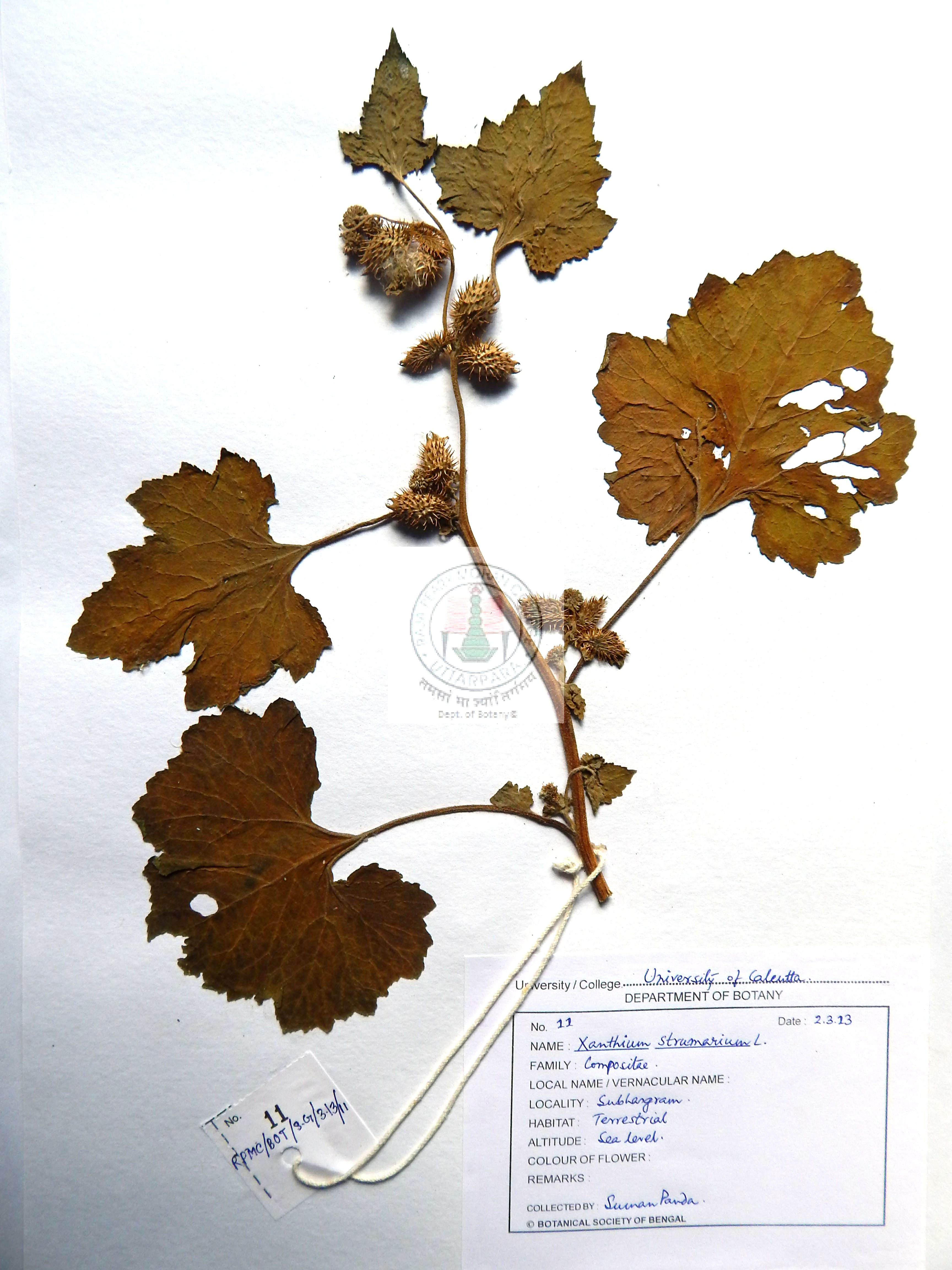
|
| 26 |
Blumea laciniata DC. |
Asteraceae (Compositae) |
An unpleasant smelling herb 1-6 ft tall from a taproot. Stems are erect to
ascending, usually branched from the base, hairless or hairy. Leaves are invertedlaceshaped,
obovate to elliptic in outline, 4.5-36.5 cm long, 0.8-21 cm wide. The lower
leaves are pinnately lobed, sometimes with a large terminal lobe, becoming
progressively less lobed above. Margins are irregularly toothed. Lower leaves have 1-6
cm long stalks, upper ones are stalkless. Flower-heads are borne in large, open
panicles at the end of branches, in capitulum. Involucral bracts are often purple-tinged,
reflexed at maturity, 1-8 mm long, hairy. Receptacle is sparsely hairy. Florets are
yellow, perfect florets 5-lobed, 4-5 mm long, marginal pistillate florets are 2-3-lobed, 3.5-
4.5 mm long. Achenes are brown, ribbed, 4 mm long.
|
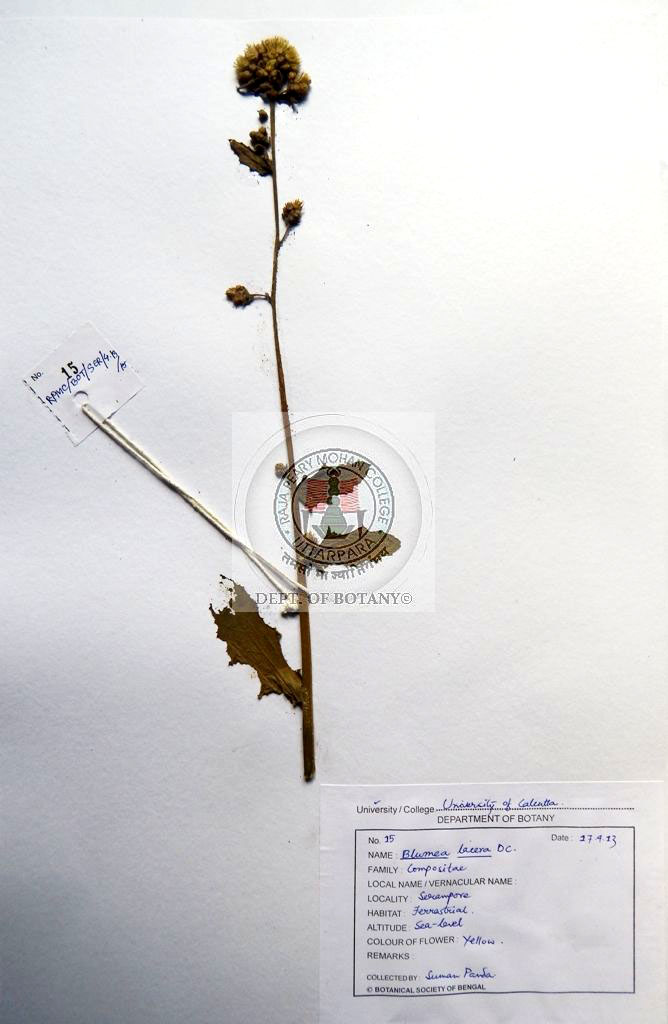
|
| 27 |
Cassia alata L. |
Fabaceae (Leguminosae) |
Annual erect diffuse undershrub; stems branched; leaves alternate,
pinnately compound, exstipulate, petiolate; petiole often with single gland; pinnae 8-10,
opposite, linear-lanceolate, stipels 0; flowers mustard yellow, arranged in corymbose
(racemose) manner in a beautiful columnar way; sepals 5, free; petals 5 free;
androecium with 10 herterodynamous (2 long + 4 medium + 4 staminodes) stamens;
placentation marginal; fruit legumes or pod, long, with 18-20 black seeds
|
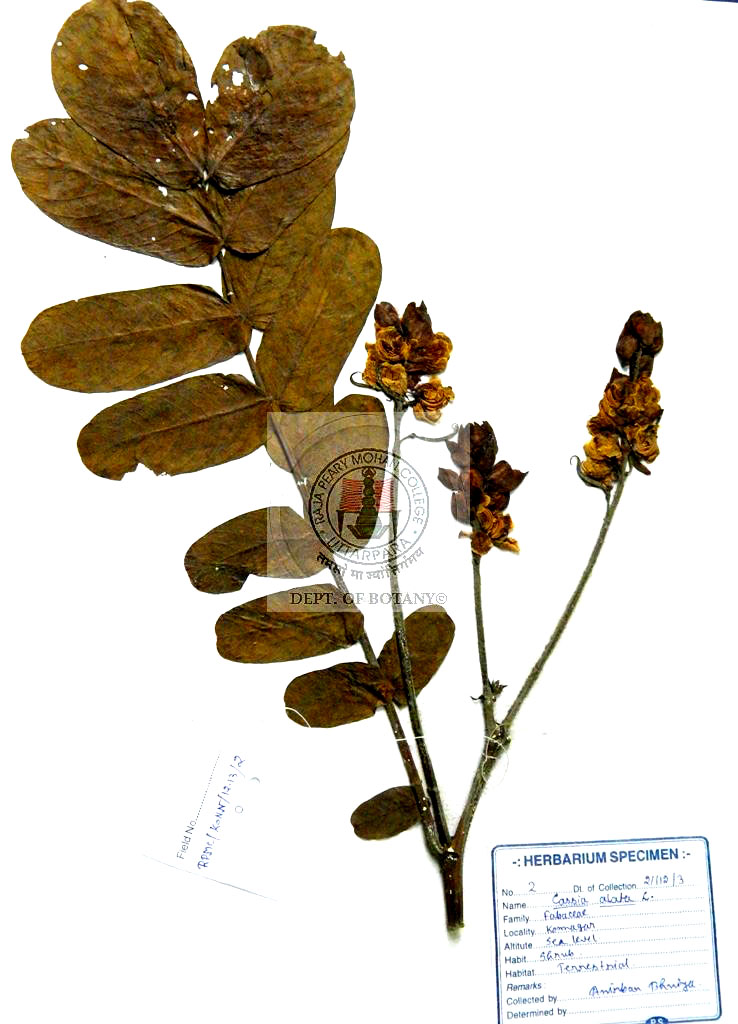
|
| 28 |
Cassia sophera L. |
Fabaceae (Leguminosae) |
Annual erect diffuse undershrub; stems branched; leaves alternate,
pinnately compound, exstipulate, petiolate; petiole often with single gland; pinnae 8-10,
opposite, linear-lanceolate, stipels 0; flowers mustard yellow, arranged in corymbose
(racemose) manner; sepals 5, free; petals 5 free; androecium with 10 herterodynamous
(2 long + 4 medium + 4 staminodes) stamens; placentation marginal; fruit legumes or
pod, long, with 18-20 black seeds
|
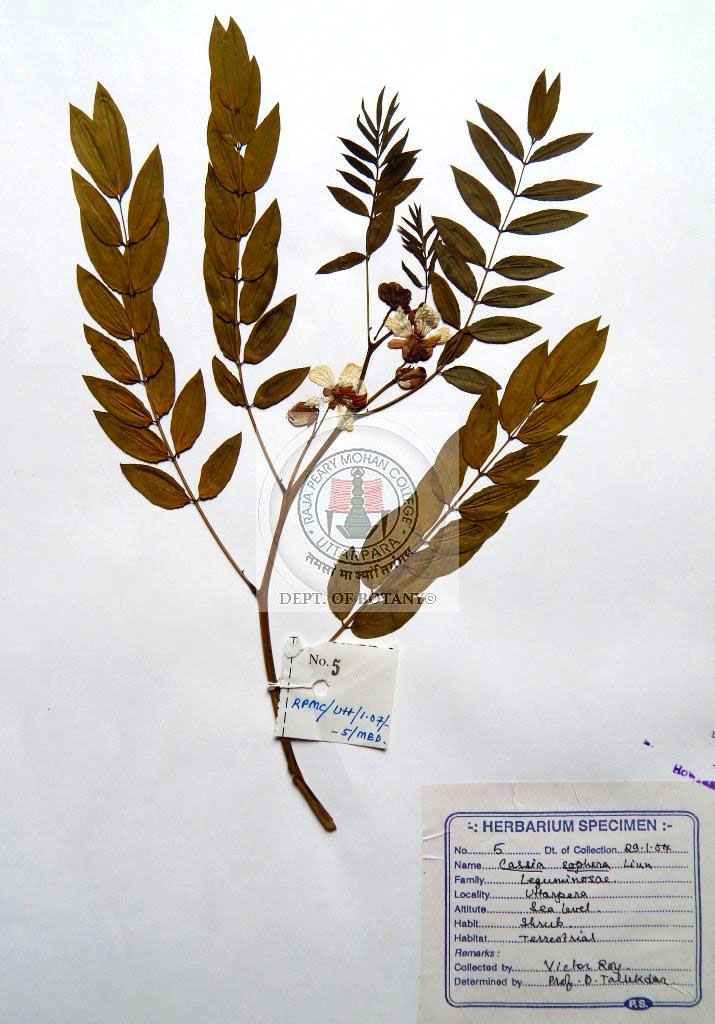
|
| 29 |
Chloris barbata Sw. |
Poaceae (Gramineae) |
A tufted, erect, annual or short-lived perennial grass, caespitose, largely
glabrous, with a short life span, heading and flowering all year round. The erect and
branching stems, which are sometimes bent at the base, are smooth and usually
flattened. They are purple or pink at the base, simple or branched, 3-5-noded, rooting at
the lower nodes, leaves are flat and narrow, linear-lanceolate, usually bluish-green with
rough edges, having long, scattered hairs on the upper surface, near the base. The
sheaths are smooth and 2-6 cm long; usually less than half as long as the internodes.
They are compressed, keeled and closely overlapping, with glabrous or bearded orifice.
The ligule is 0.5-1.0 mm long, membraneous and fringed with short hairs; inflorescence
terminal, composed of a whorl of 5-15 digitate spikes which are densely clustered,
usually ascending, purple and 5-8 cm long with three-flowered spikelets (one fertile
flower). These are purplish and densely overlapping, with three slender awns. The
glumes are unequal, narrow, acute and membraneous except for a single green nerve.
The first is 1-1.5 mm long and the second 2-2.5 mm long. There are almost always three
florets which are often purple. The lemmas are three-nerved. The first lemma is obovate,
keeled and 2-2.5 mm long, sparsely to densely pilose on the margins and the keel. The
awn is 5-10 mm long. The palea is 2-2.5 mm long, nearly as broad as the lemma with
marginal keels. The apical rudiment is approximately 1 mm long and consists of two
inflated, triangular-truncate, thin, glabrous, sterile lemmas, one within the other, each
with an awn 3-5 mm long.
|
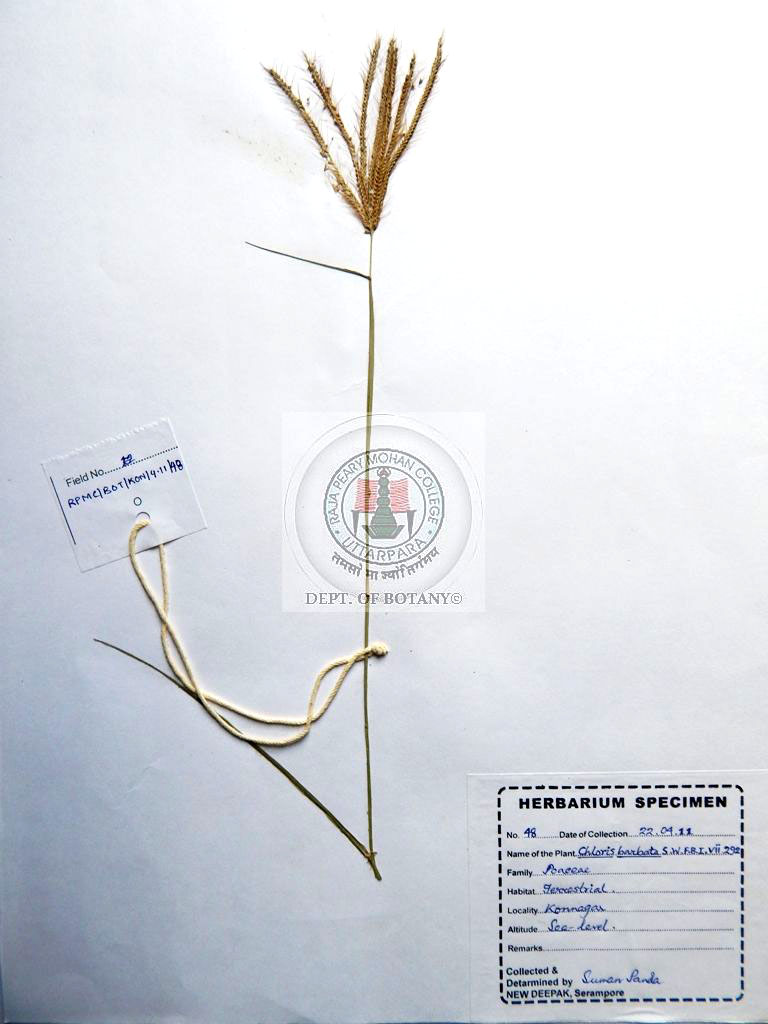
|
| 30 |
Cleome monophylla L. |
Capparaceae |
Erect or spreading annual herb; stem densely covered with short
glandular and longer non-glandular hairs; leaves alternate, simple; petiole up to 2.5 cm
long; leaf usually lanceolate or oblong, sometimes ovate or linear-lanceolate, entire at
margin, pubescent on both surfaces with hairs like those on the stem; flowers bisexual,
small, 4-merous; pedicel up to 1 cm long, arranged in a few-flowered, terminal raceme;
sepals narrowly lanceolate; petals free, obovate to oblanceolate, at base tapering into a
thin claw about as long as the sepals, pink to purple; stamens 5–6, two inner ones
slightly longer than outer ones, filaments 5–6 mm long; ovary superior, 1-celled,
pubescent, style short, stigma capitates; fruit a spindle-shaped capsule with stalk up to
4 mm long, densely covered with glandular and non-glandular hairs, completely
dehiscing with 2 valves. Seeds flattened to subglobose, dark brown with fine
longitudinal striations and low transverse ridges.
|
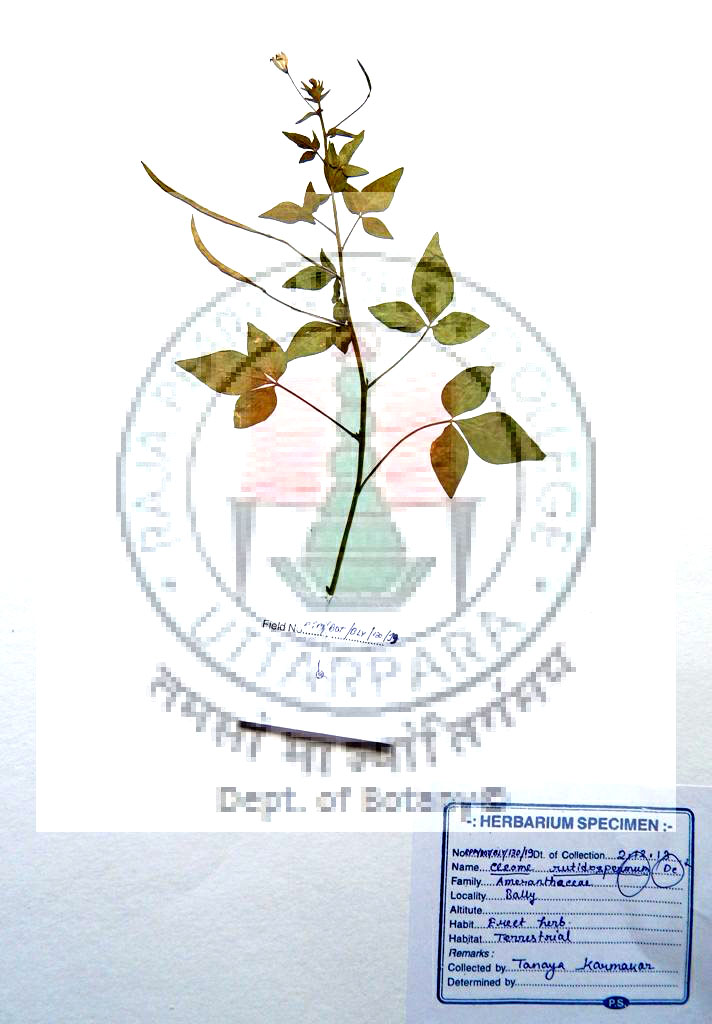
|
| 31 |
Digitaria ciliaris (Retz.) Pers. |
Poaceae (Gramineae) |
An annual decumbent grassrooting at the nodes and spreading to form
untidy patches up to 1 m across and 50 cm high; leaves reach up to 25 cm length and 1
cm in width; sheaths and lower parts of leaves loosely hairy on both surfaces; ligule
membranous, inflorescence spikelet (racemose), 1-3 mm long Inflorescence on a long
culm, usually much taller than the foliage, consisting of 2-9 racemes 5-10(-15) cm long,
sub-digitate with one or more inserted up to 1 cm below the others; spikelets, arranged
in pairs, one sessile and the other shortly pedicelled, tapering to an acute tip. The lower
glume is a very short but distinct scale about 0.3 mm long; the upper glume at least half,
usually about 3/4 the length of the spikelet, with three nerves. The upper lemma is as
long as the spikelet and has 5-7 nerves, usually with a distinct space each side of the
central one. The lateral nerves are smooth, variable in hairiness, sometimes with very
long hairs. The upper lemma is smooth with only one nerve, grey to light brown. Grain
caryopsis, 1.5-2 mm long.
|
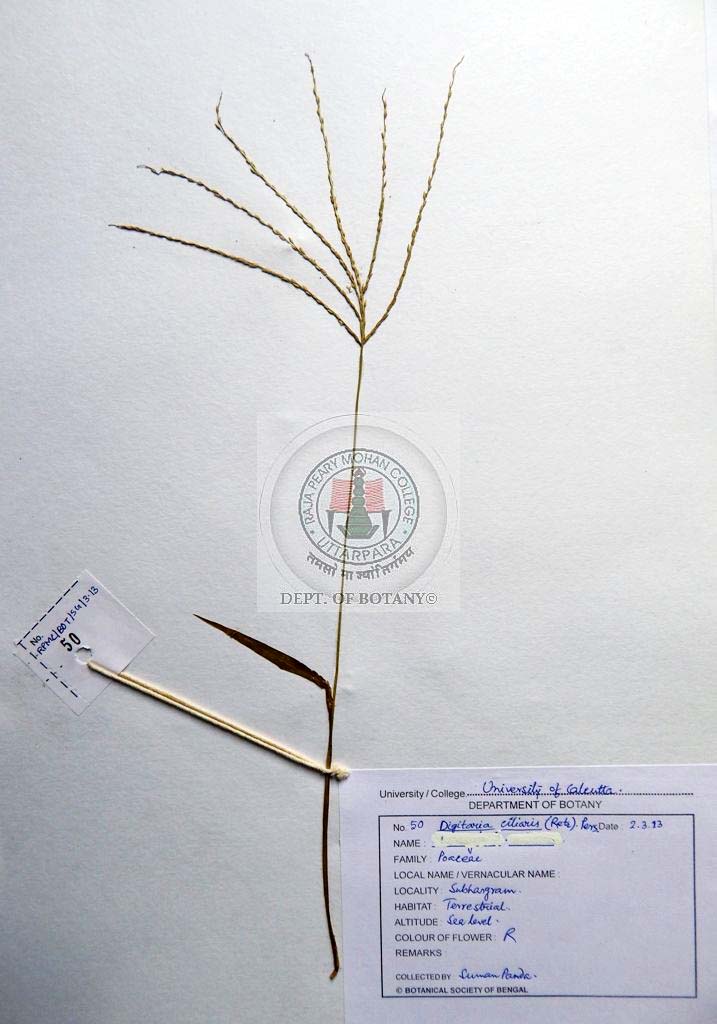
|
| 32 |
Echinochloa crus-galli (L.) P. Beauv. |
Poaceae (Gramineae) |
Annual, tufted grass with fibrous, rather shallow roots; stems stout, erect
to decumbent, Plant branching from the base, rather tall, 80 -150 cm, first leaves are
dull or grayish green, with the stem purplish tinged, the youngest leaf is rolled; leaf
blades are glabrous, hairless, elongate, 5-20 mm wide, 8-60 cm long, with a white
midrib; culms erect to decumbent; inflorescence racemose; panicle erect or nodding,
green or purple-tinged, 9 - 12 racemes, long, spreading, ascending, sometimes
branched; spikelets crowded, about 3 - 4 mm long excluding the awns, first glume 1/3
as long as the spikelet; second glume and sterile lemma with short bristly
hairs. Awnless or on the nerves with awns, mostly 5 - 10 mm long; fruit caryopsis, small
|
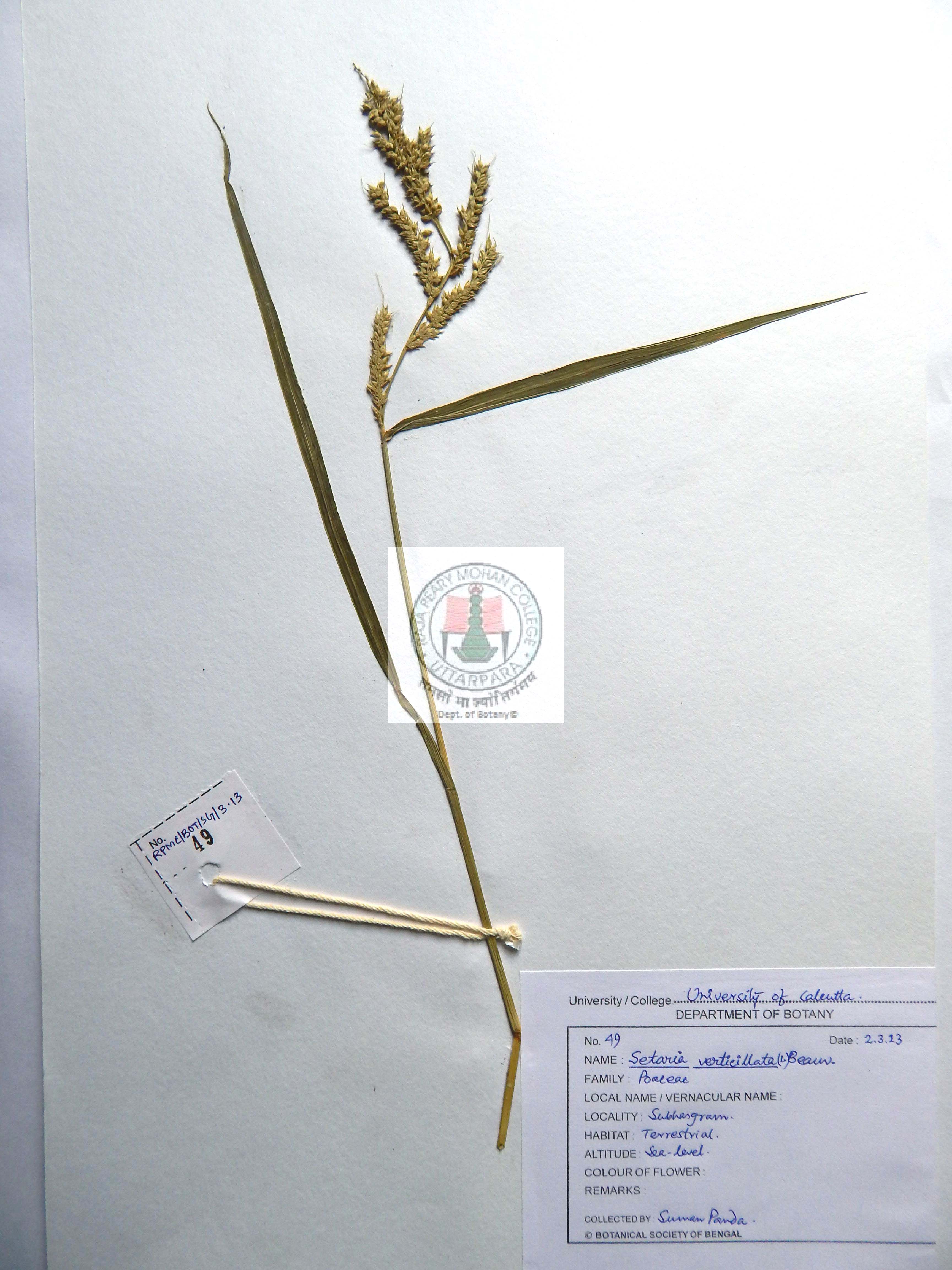
|
| 33 |
Eupatorium adenophorum Spreng. |
Asteraceae (Compositae) |
An erect, bushy, leafy, many-stemmed herb, growing to 2 m tall. It commonly
occurs in disturbed areas; stems purplish, cylindrical, branched stems are densely covered in
sticky glandular hairs when young; leaves simple, opposite, soft, thin, shaped like a triangle or
rhombus, with a toothed edge and conspicuous veins, dark green on the upper surface, lighter
underneath, and may be slightly hairy; 4-12cm long, 3-9cm wide; Flowers comprise 50 to 70
white, tubular florets about 3.5 mm long; grouped into heads 5-6 mm diameter within a row of
green bracts and arranged in flat clusters up to 10 cm across at the end of the branches, small
white flower-heads capitula consist of several tiny flowers tubular florets surrounded by two
rows of greenish bracts (an involucre) 3-5 mm long. These flower-heads (5-8 mm across) are
borne in large numbers and arranged in clusters at the tips of the branches
in terminal corymbose inflorescences); fruits cypsela; seeds dark brown to black, slender,
angular; topped by a pappus of 5 to 10 fine white hairs.
|
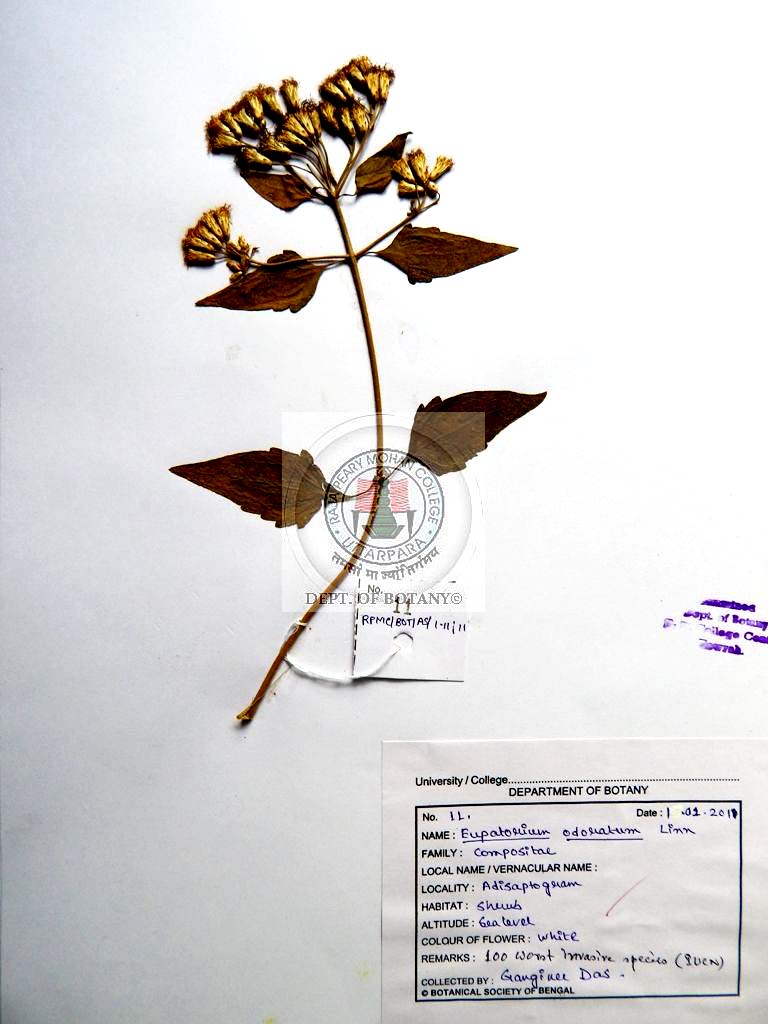
|
| 34 |
Euphorbia hirta L. |
Euphorbiaceae |
An annual prostrate hairy herb with watery latex, slender- stemmed, with many branches
from the base to top, spreading upto 40 cm in height, reddish or purplish; leaves linear to ovatelanceolate,
simple, opposite-decussate, dark green above, pale beneath, blotched with purple in the
middle, and toothed at the edge, exstipulate, shortly petiolate; flowers small, unisexual, arranged in
axillary cymes at each leaf node, purplish to greenish in color, dense, axillary, short-stalked clusters or
crowded cymes, about 1 mm in length, shortly pedunculate; fruit yellow, three- celled, hairy, keeled
capsules, containing three brown, four-sided, angular, wrinkled seeds. The specific name, hirta, has
reference to the peculiar hairy condition of the plant.
|
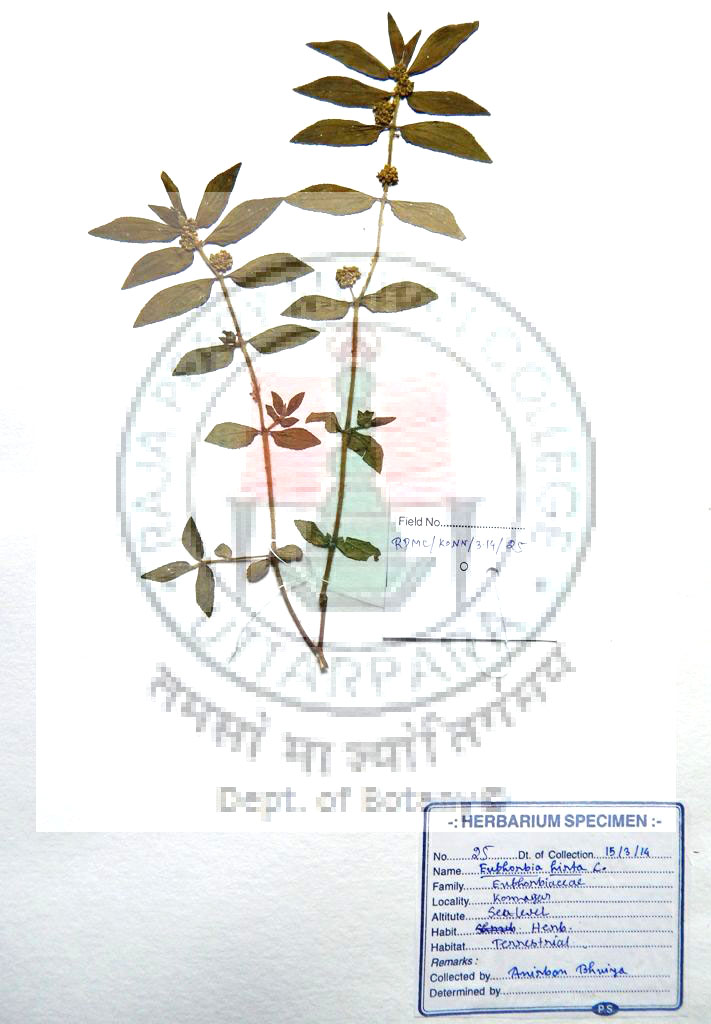
|
| 35 |
Leonurus sibiricus L. |
Lamiaceae (Labiatae) |
An annual erect herb; stems 4-angled, solid, and covered in appressed hairs;
leaves are deeply divided into 3 lobes, which may be further divided with short, narrow lobes or
a few small teeth around the edge, lower leaves are long, long-stalked, and more broadly lobed
than upper leaves, up to 6 inches but wither away early. Leaves become progressively smaller
with narrower lobes and shorter stalks as they ascend the stem; upper leaves are about 2
inches long and 1½ inches wide; surfaces are sparsely short-hairy, the underside glandular;
flowers whitish-pink to pink, sometimes white, bracteate, clusters of stalkless flowers surround
the stem at the leaf nodes in the upper part of the plant, tubular, arranged in verticillaster
inflorescence; sepals five connate below, irregular, persistent; corolla 2-lipped; upper lip
extends out, its outer surface densely covered in short, white hairs, the lower lip is a notched at
the tip; stamens 4, epipetalous, didynamous (2+2), Purple-tipped; carpels 2, style gynobasic,
white, ovary superior in axile placentation, stigma unequally bifid; fruits a 4-seeded nutlets
(cercerule) with persistent calyx
|
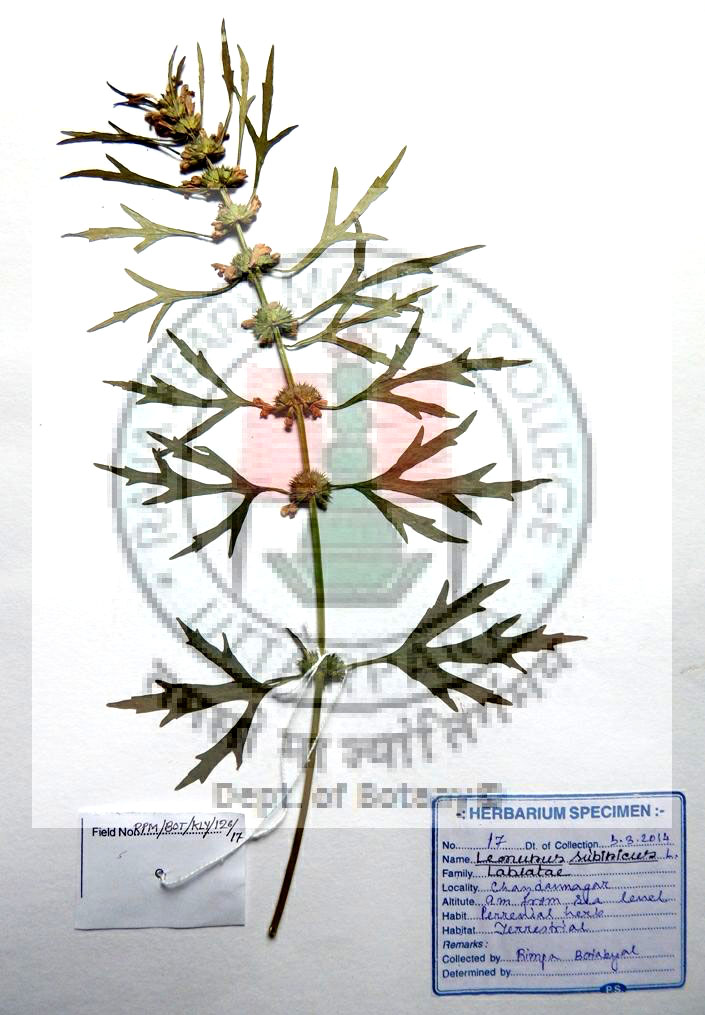
|
| 36 |
Leucaena leucocephala (Lam.) de Wit |
Fabaceae (Leguminosae- Mimosoideae) |
An evergreen small scrubby tree with loosely arranged branching; leaves
bipinnately compound with 3-10 pairs of leaflets, linear-lanceolate, alternate; flowers
white, borne in dense globular clusters (12-30 mm across), looking like a ‘pompom’ in
full bloom, borne in the leaf forks on peduncle which is 2-6 cm long, with one to three
clusters present in each leaf axil; sepals five, tiny; corolla white; stamens 10, paleyellow
or whitish; fruits pods, elongated, linear, flattened with pointed beak / apex
|
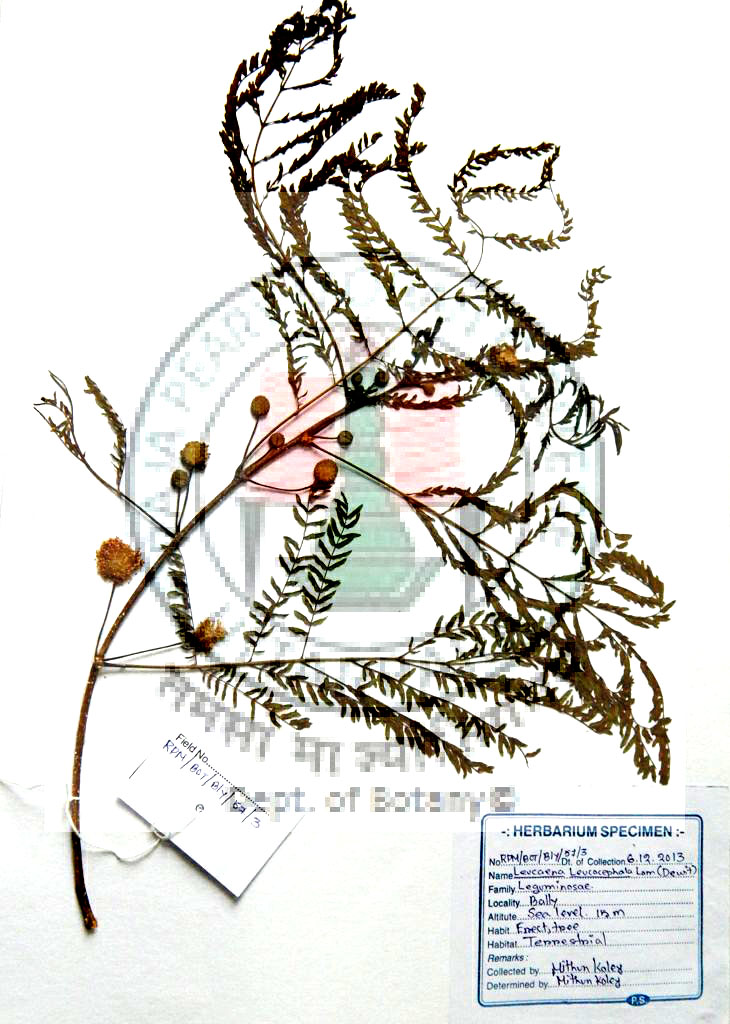
|
| 37 |
Mikania micrantha Kunth |
Asteraceae (Compositae) |
An extremely fast-growing, perennial creeping climber (vine), branched, slender,
twine-stemmed; stems ribbed lengthwise (i.e. longitudinally) and are either hairless (i.e.
glabrous) or slightly hairy (i.e. puberulent).leaves simple, glabrous, opposite, pairs along the
stems and are heart-shaped or triangular, thin, broadly ovate, shallowly or coarsely toothed,
triangular or ovate, acute at apex, broad at base; flowers, each 3-5mm long, are arranged in
dense terminal or axillary corymbs with numerous florets arranged in a capitulum; individual
florets are white to greenish-white, surrounded by a row of four small green bracts
(i.e. involucre). These bracts (2-4 mm long) are oblong to egg-shaped in outline (i.e. obovate)
with pointed tips (i.e. acute apices); fruit typical cypsela; seeds black, linear-oblong, five-angled
and about 2mm long with terminal pappus of white bristles that facilitates dispersal
|
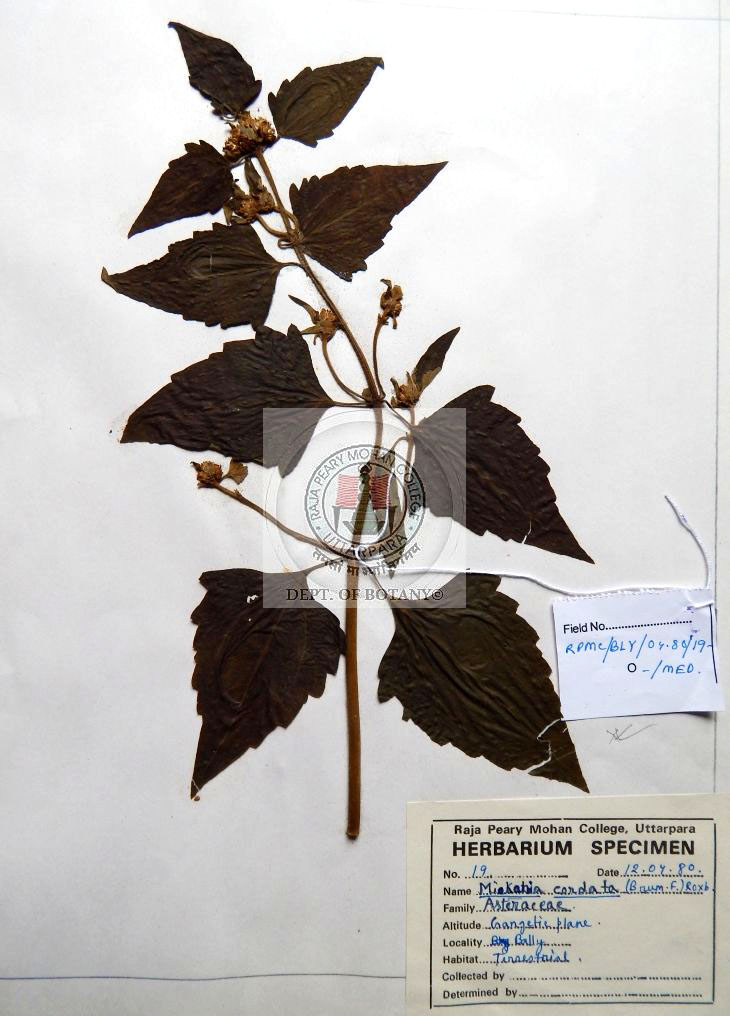
|
| 38 |
Nicotiana plumbaginifolia Viv. |
Solanaceae |
An erect, annual, viscid-hairy herb with lax branching; stems solid, round,
densely hairy; leaves linear-lancedolate, basal leaves ovate to oblanceolate, simple,
alternate, wavy at margin, acute at apex, cuneate to decurrent at base, exstipulate;
flowers pinkish-white, long, tubular, ebracteate, bisexual, arranged in a lax raceme,
axillary; sepals 5, connate, nervose; corolla tubular; anthers 5, adnate with corolla tube
below, shorter than filaments, ± oblong; carpels 2, placentation axile, ovary obliquely
placed; fruits capsule ovoid, ± included in the persistent calyx; seeds subglobose to
angular, minutely rugose-reticulate, brown.
|
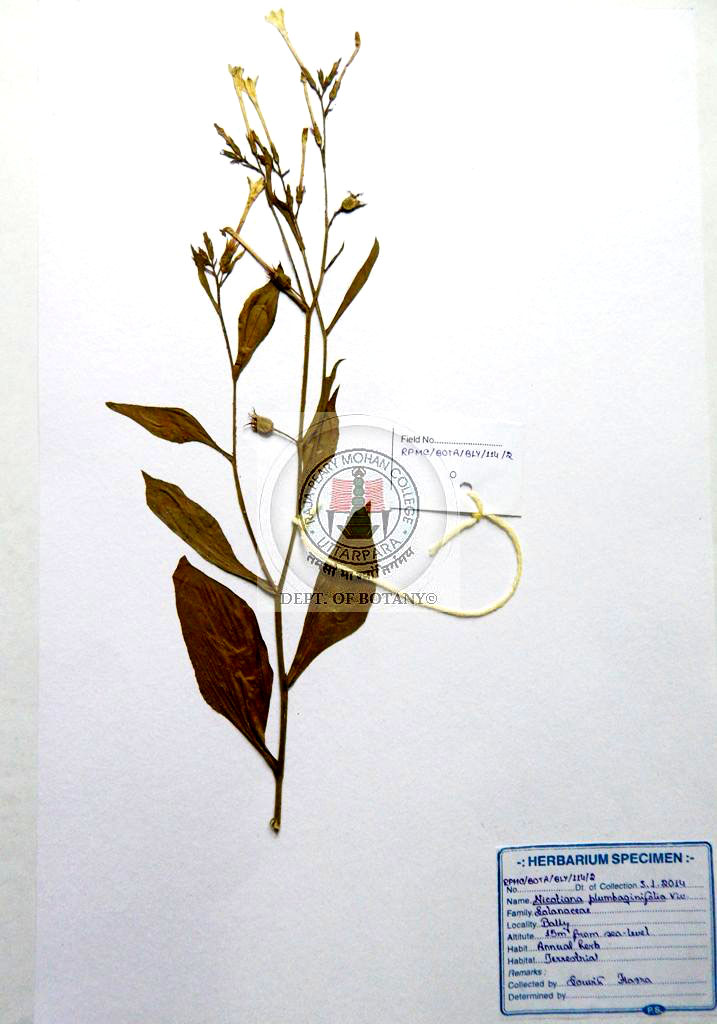
|
| 39 |
Rivina humilis L. |
Phytolaccaceae |
perennial erect shade-tolerant herb; leaves about 4-12 x 1.5-4 cm, quite
thin, simple, alternate, wilting quickly when picked. Twigs glabrous, longitudinally
grooved, rather pithy. Scattered pale-coloured hairs usually present along the midrib on
the underside of the leaf blade. Petiole with two rows of glandular hairs on the upper
surface; flowers tiny pale pink-white, are about 1/4 inch across, white to pink, growing
on the last 2-3 inches of the stems, arranged in a raceme; tepals about 2-2.5 mm
long, glabrous; anthers glabrous; ovary subglobose, glabrous, style short with an
extension running down the side of the; fruits are numerous, berry, brilliantly red and
almost translucent, often appearing on the lower part of the stem while the upper part is
still blooming.
|
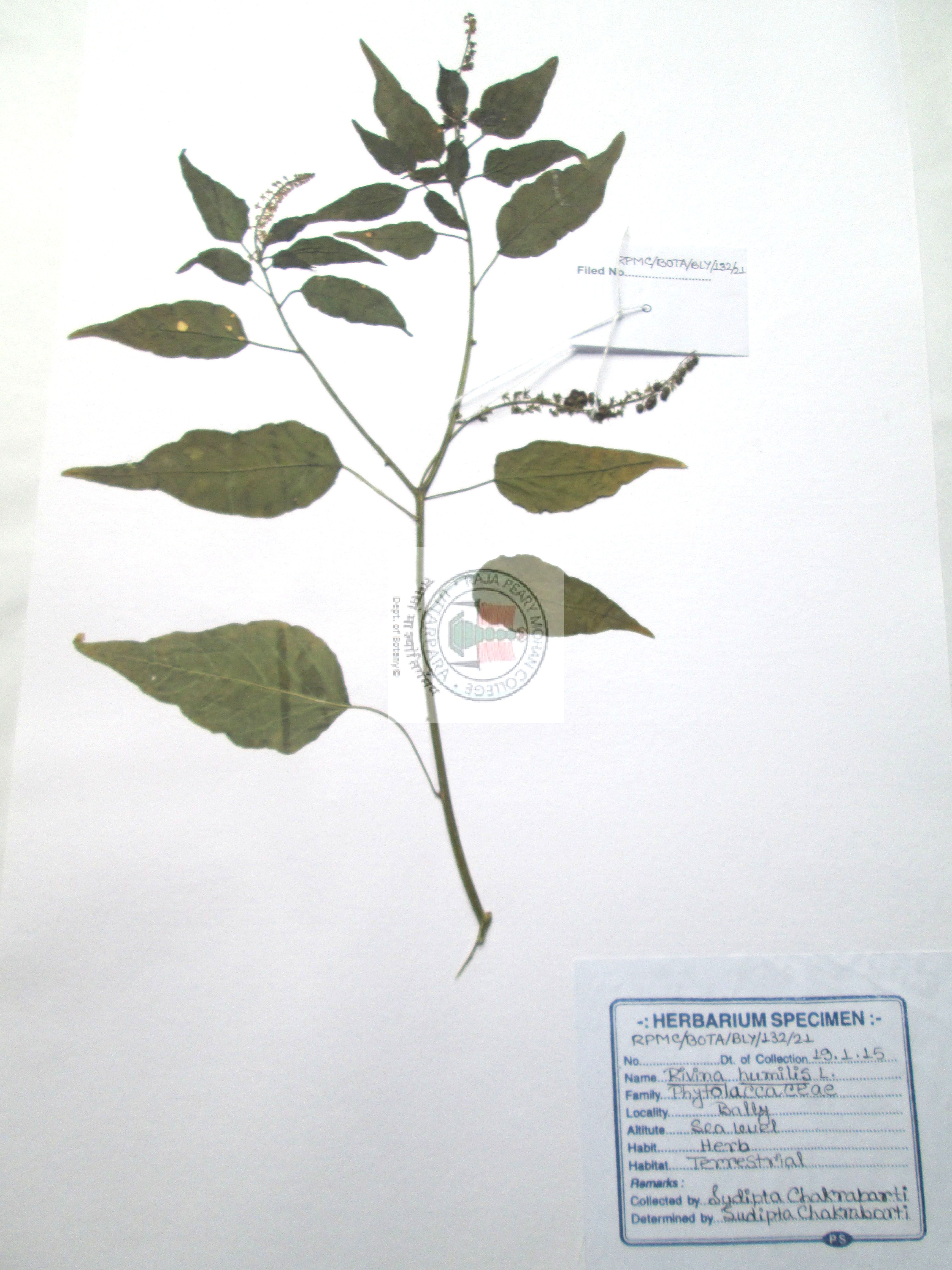
|
| 40 |
Schoenoplectus articulatus (L.) Palla |
Cyperaceae |
Herb reaching 30-85 cm in length (including involucral bract); stem
rhizomatous; hizomes shortly creeping; culms densely tufted, terete, transversely
septate, clothed at base with 1 or 2 bladeless leaf sheaths; terete, obliquely truncate at
mucronate mouth; Involucral bract 1, erect, culm like, usually longer than culm, with
many transverse septate nodes; inflorescence a pseudolateral head with many at least
25 spikelets; spikelets sessile, ovoid, many flowered; glumes brownish yellow with dark
brown lines, deltoid-ovate, 5-5.5 mm, concave, thinly membranous, apex with a costa
excurrent into a mucro; perianth bristles absent; stamens 3; stigmas 3; fruits nutlet
yellowish gray at maturity, obovoid, 3-sided, smooth.
|
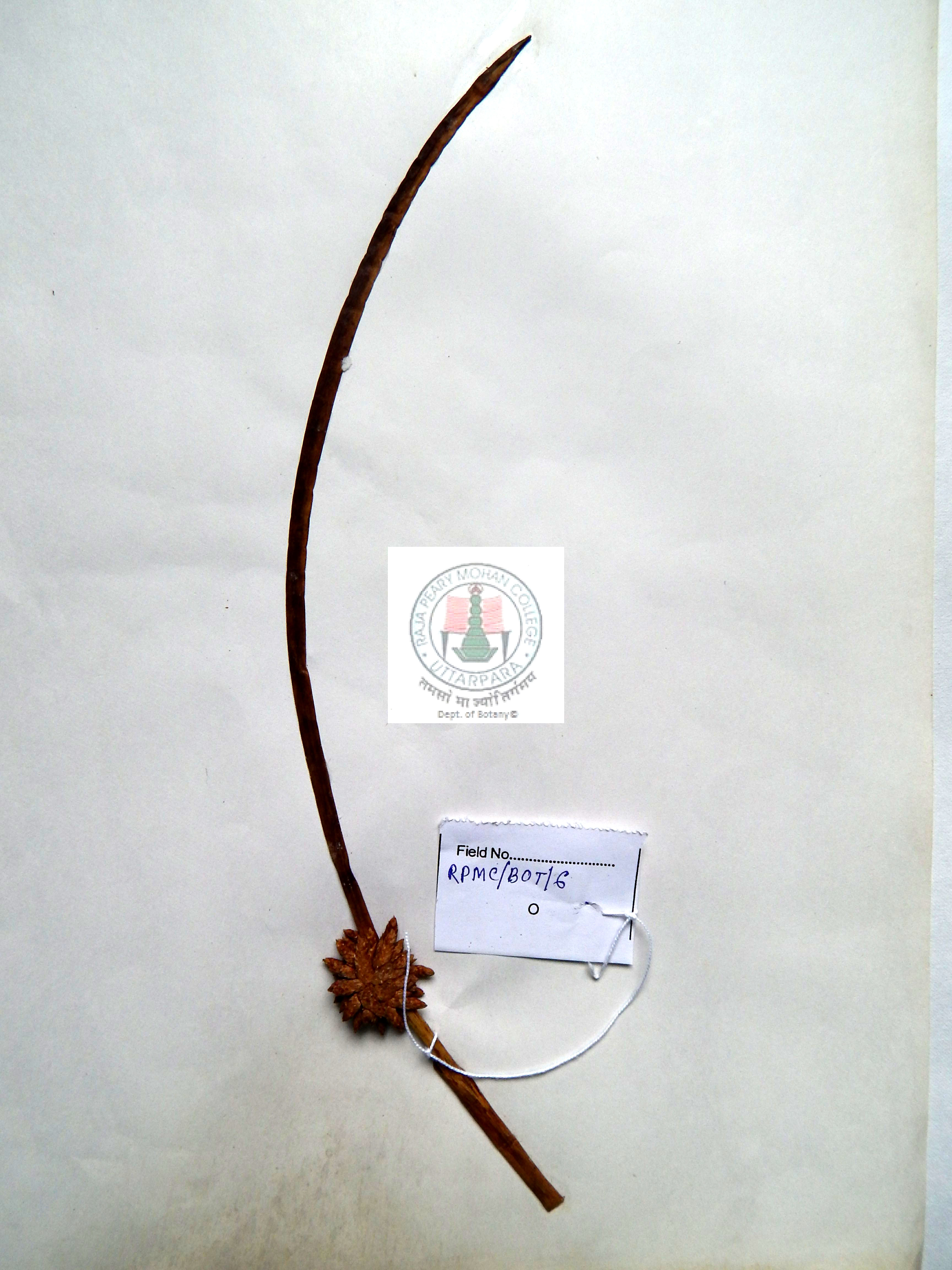
|
| 41 |
Scoparia dulcis L |
Scrophulariaceae |
Erect, annual or perennial herbs. Leaves decussate to whorled,-oblong,
base attenuate, margin crenate-serrate, apex acute, penninerved, punctate,
chartaceous; petiolate; flowers axillary, solitary or 2, white; pedicelled Calyx lobes -,
ovate-oblong, ciliate along margin; corolla, rotate, semi-regular, throat densely hairy,
lobes spathulate. Stamens 4, subequal; vary globose, 2-celled; ovules many; stigma
truncate, fruit-capsules, ovoid or rounded
|
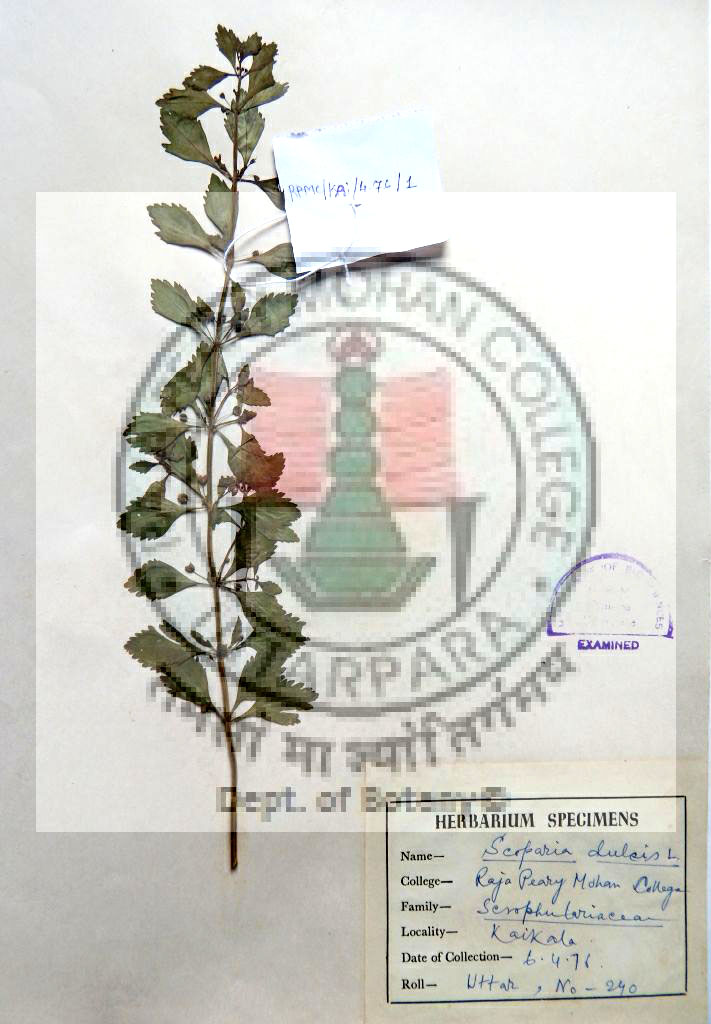
|
| 42 |
Sonchus arvensis L. |
Asteraceae (Compositae) |
Perennial herb, rhizome present, leaves alternate and waxy, flowers
dandelion like, flower heads are often covered with sticky hair; fruit cypsela
|
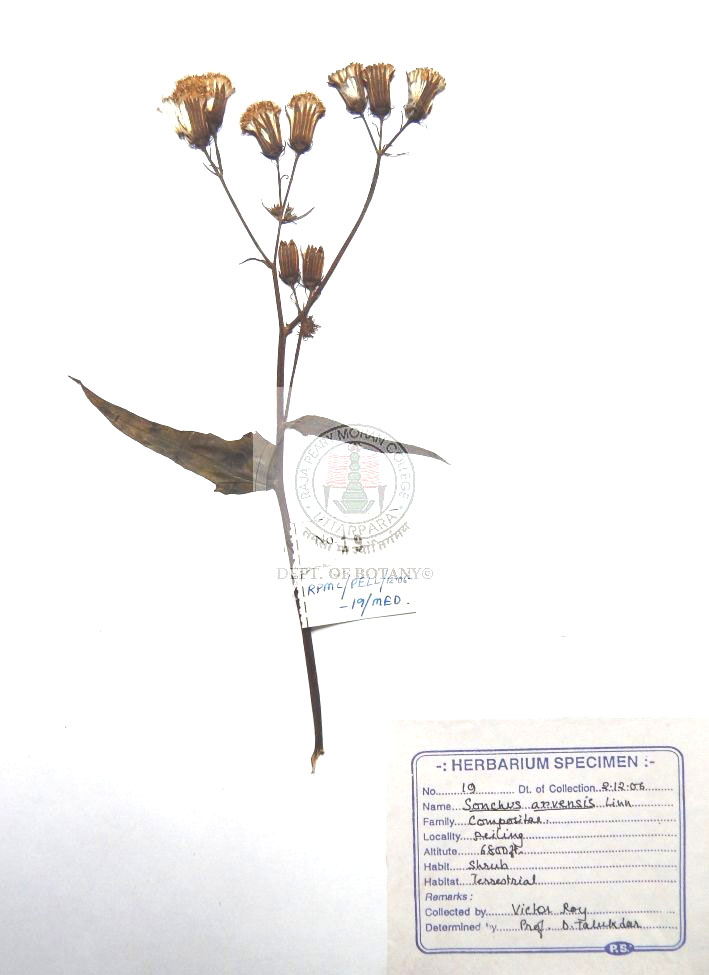
|
| 43 |
Synedrella nodiflora Gaertn. |
Asteraceae (Compositae) |
An annual tall, erect, herb; long internodes and swollen nodes, to be
rounded or slightly angular; leaves simple, opposite-decussate, ovate-lanceolate,
hispidly hairy, acute at apex, crenate-serrate at margins; floral heads axillary or between
forks of branches, pale yellow, arranged in a distinct heterogamous capitulum as small
crowded bunches of 2-8 inflorescences at nodes, each inflorescence consists of several
erect bracts 3-5 mm long surrounding 5-6 marginal ray florets and 10-20 central disc
florets ; both ray and disc florets yellow; fruits cypsela-achenes; of ray florets
prominently ribbed, lacerate, those of disc florets compressed, subtrigonous, minutely
tuberculate. Both types of seed produce identical individuals, which in turn produce both
types of seed.
|
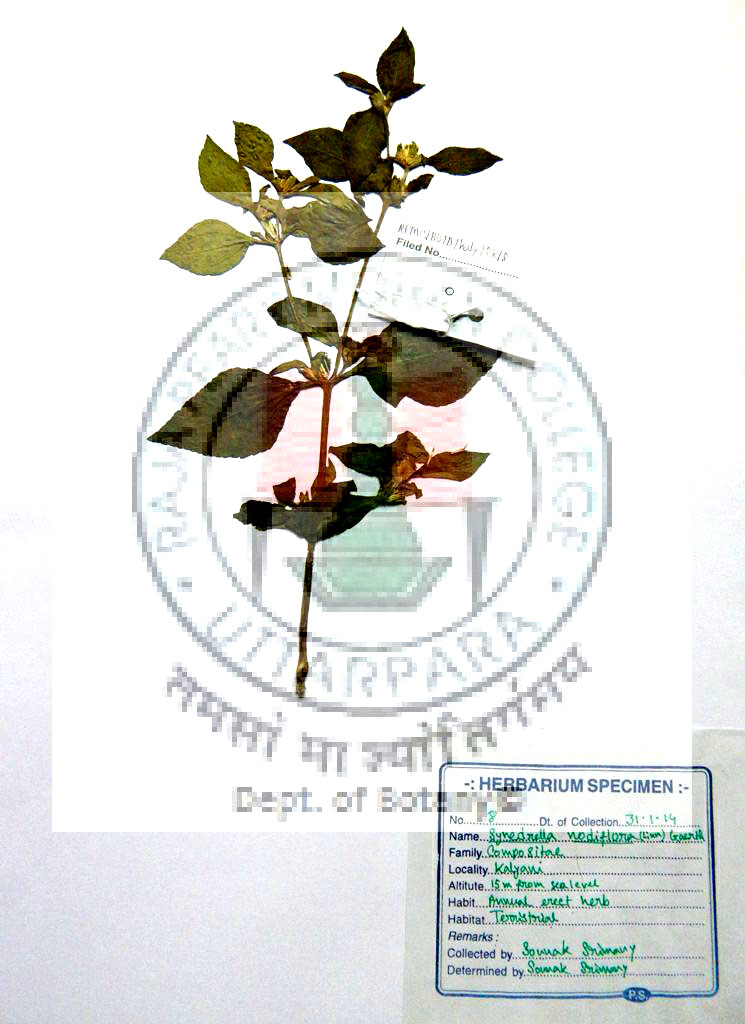
|
| 44 |
Tridax procumbens L. |
Asteraceae (Compositae) |
Perennial herb with firm taproot; stems cylindrical, often purplish, decumbent
trailing, sparsely and patently long- and white-pubescent; leaves opposite, oblong-ovate,
herbaceous or somewhat succulent; pinnately nerved, midrib strongly prominent below, both
sides sparsely and patently long white-hirsute; flower heads terminal and axillary, erect-patently
long-peduncled, rather sparsely long-hirsute; three-seriate, base attenuate; outer bracts
smallest, foliaceous, green; green; inner ones membraneous, usually purplish-margined;
receptacle slightly convex, paleate; paleas linear, subpersistent; arranged in capitulum with ray
and disc florets; ray flowers 5-6, female; corolla 8-9 mm long with greenish-yellow limb, 3-4
lobed, pale yellow or white; ovary long, white, hairy. Disc flowers numerous, dense, erect, inner
flowers numerous, dense, erect, inner ones longest; corolla 6-7.5 mm long, bright yellow, lobes
5; ovary with long white hairs; anthers cuneate, yellow with apical valve; style arms long, acute,
pilose. Achenes cypsela -angular, dark brown to black, densely white long-hairy, stiff, feathered,
unequal bristles.
|
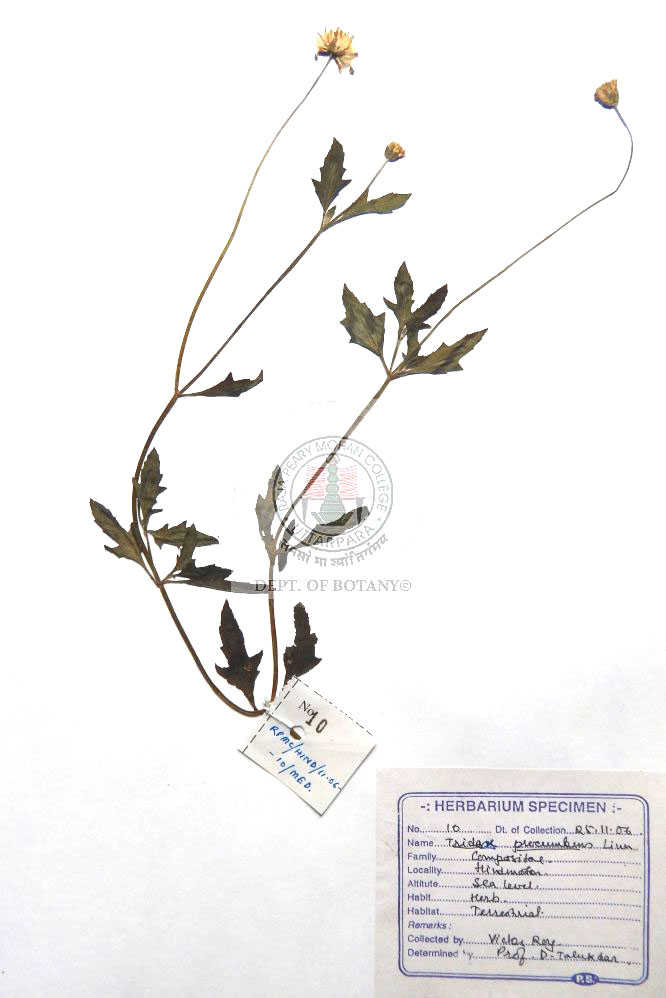
|
| 45 |
Vernonia solidaginifolia Bojer ex DC. |
Asteraceae (Compositae) |
An annual erect herb; leaves linear lanceolate, thinly hair below;
corymbose cymes (homogamous capitulum), pedunculate, flower bluish yellow ,
bisexual, sessile, anthers syngenesious; fruit achene (cypsela)
|
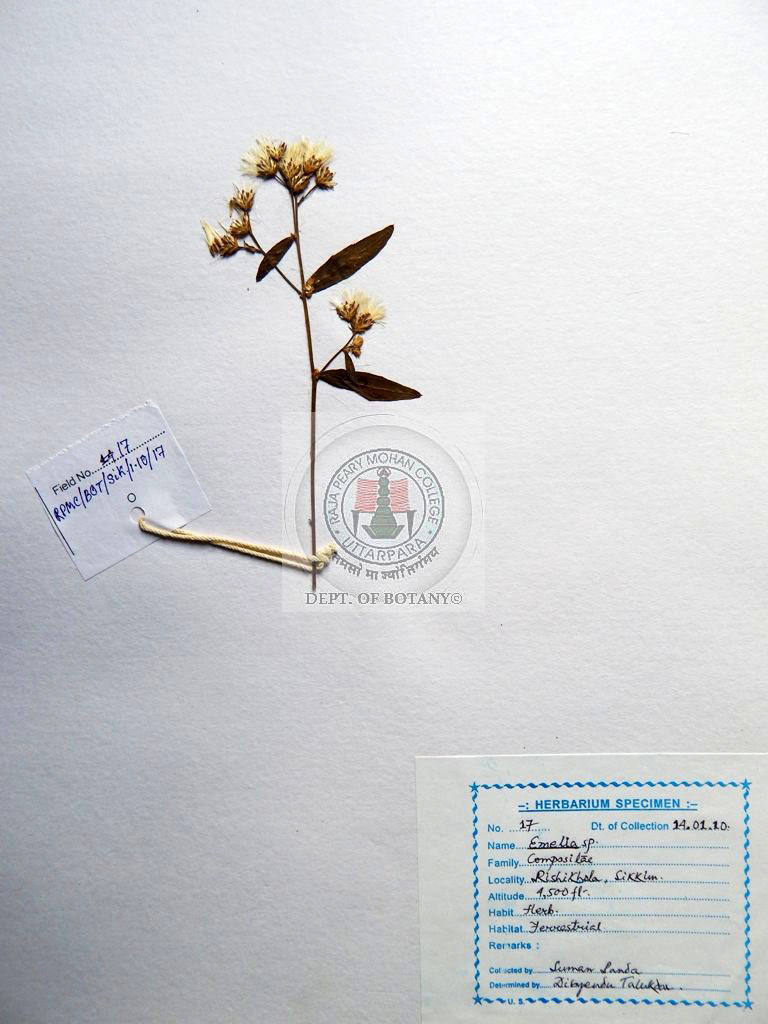
|
| 46 |
Gnaphalium indicum L. |
Asteraceae (Compositae) |
An annual erect ascending, wooly annual herbs, grows up to 0.15 m, ; leaves sessile, semi-amplexicaul at base, oblong, spathulate or oblanceolate, woolly on both surfaces, obtuse at apex, sometimes mucronate, entire at margins, those at apical nodes linear-oblong, acute at apex; flowers arranged in capitula borne in dense terminal corymbs, golden-yellow, glistening; involucre bracts shining, straw-coloured, sub-herbaceous at base and transparent towards apex, outer ones ovate, sub-acute, inner linear, acute or sub-acute. Ray-florets: numerous, pappus shorter than the involucre. Disc-florets: slender; style-branches truncate; fruits cypsela oblong, papillose; Achenes are tubercled or have minute curved bristles
|
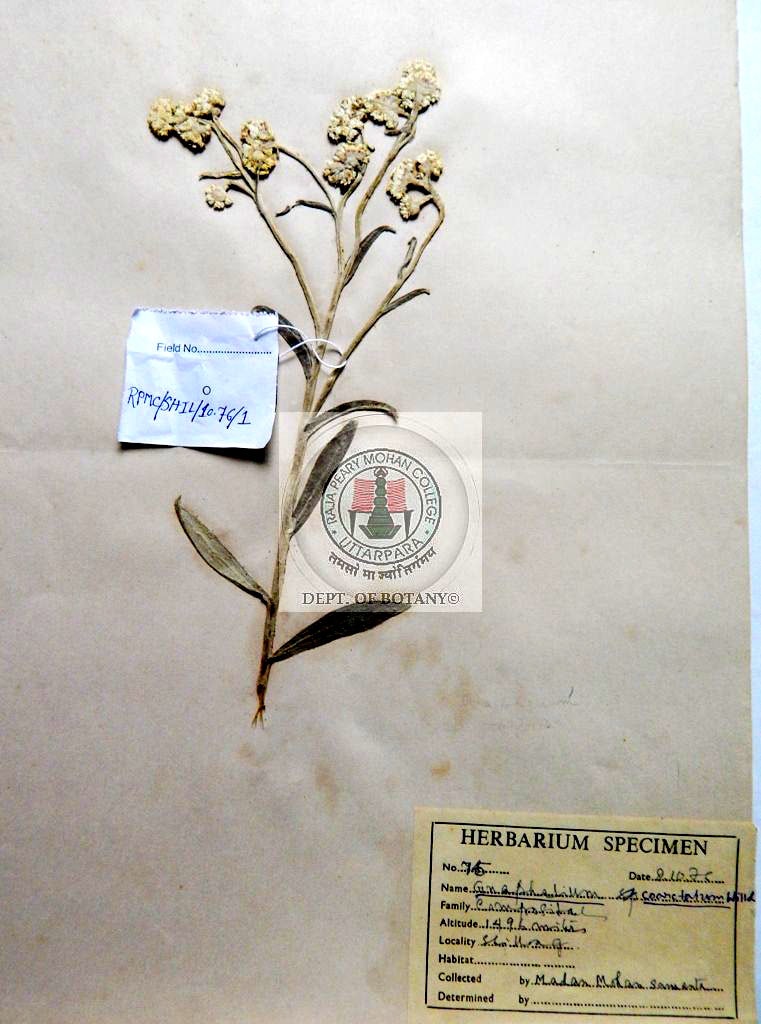
|
| 47 |
Gomphrena celosioides Mart. |
Amaranthaceae |
Perennial herb, decumbent, branched from the base; stem solid, white, villous; leaves elliptic to lanceolate, opposite, white-grayish hairy especially towards the apex; acute to obtuse at apex, round at base; flowers small, white, papery, wolly arranged in terminal cylindrical spike, lowers are hidden among the white, petal-like bracts; fruits achene-one seeded
|
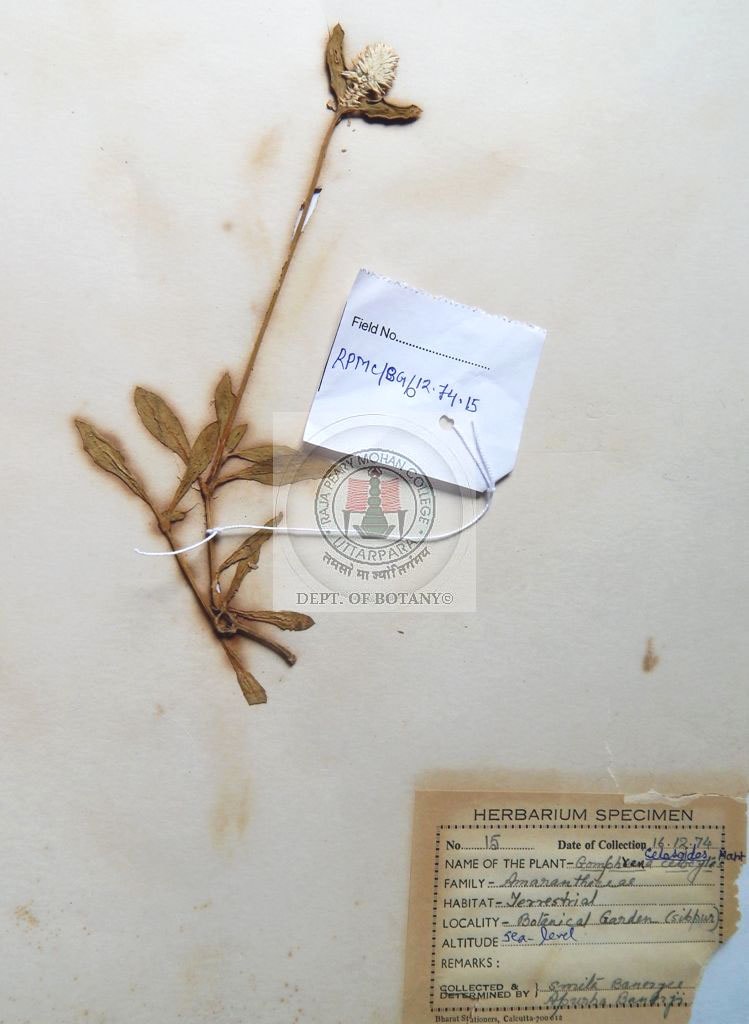
|
| 48 |
Gymnopetalum cochinchinense (Lour.) Kurz. |
Cucurbitaceae |
Monoecious climbing herb, stems slender, angular, sulcate, scabrous-hairy; tendrils simple, filiform. Leaves membranous; scabrous, ovate-cordate, angled; base deeply cordate; apex acuminate; margin undulate, sparsely dentate; probract absent. Male inflorescence raceme; bracteates; flowers solitary, peduncle long, bract prominent, obovate, incise-serrate. Male flower solitary; calyx tube elongate, villous, wider at apex; sepals linear; stamens-3, inserted. Female flower solitary, in the same or different axil as male inflorescence. Ovary pubescent; narrowly ellipsoid. Stigma 3. Fruits are ovoid-oblong and ribbed
|
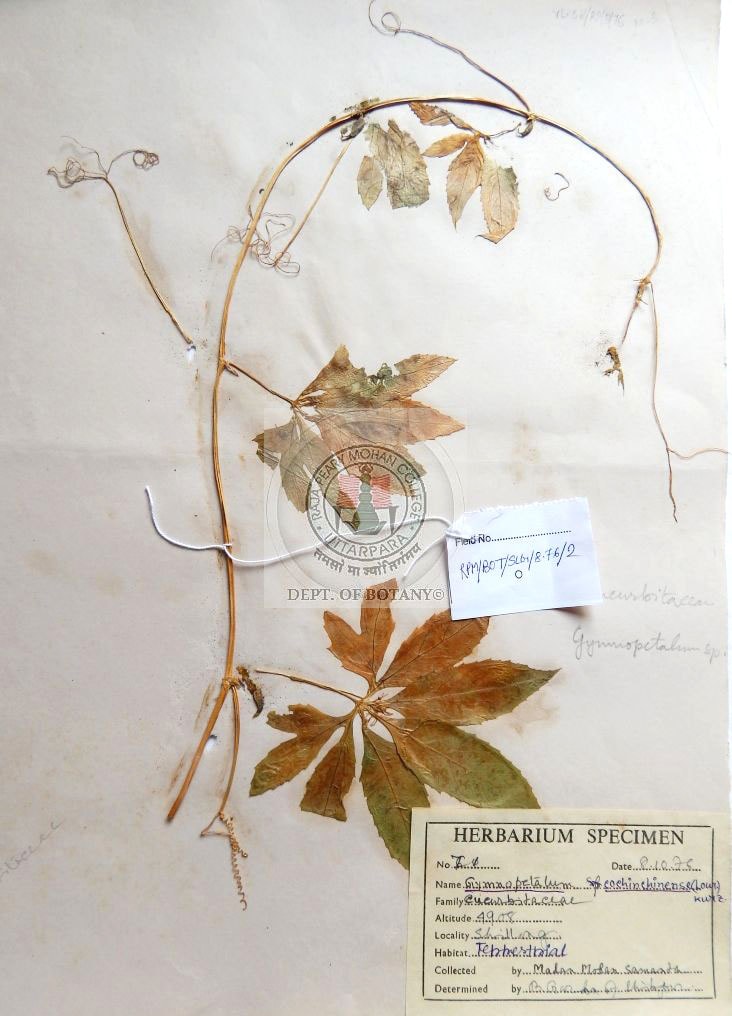
|
| 49 |
Hibiscus vitifolius L. |
Malvaceae |
Perennial herb up to 1•5 m. tall, sometimes scandent or scrambling; stems terete, nearly glabrous or with a very variable indumentum, sometimes tomentose or tomentellous, often glandular, sometimes hispid or stellate-hispid or aculeate and with these different types of hairs occurring in various combinations; leaf-lamina, ovate to suborbicular; not lobed to deeply 3–5 (7)-palmatilobed, with a variable indumentum (as on the stems) but stellate hispid or bifurcate hairs, rather rare on the stems, are more frequent especially on the under surface, margin serrate, base truncate to cordate, strongly nerved; lobes acute or bluntish; petiole hairy; flowers yellow with a dark reddish or purple centre, pendent solitary or forming terminal racemes by reduction of the upper leaves; epicalyx of c. 10 bracts, filiform; calyx long in flower, accrescent, somewhat scarious; broadly elliptic, acuminate, joined to about half-way; corolla regular, yellowish-crimson, Staminal tube up to 15 mm. long; free parts of filaments up to 5 mm. long; style-branches 1•5–3 mm. long, minutely glandular; fruits-Capsule, winged, scarious, usually hispid; valves ± aristate. http://powo.science.kew.org/taxon
|
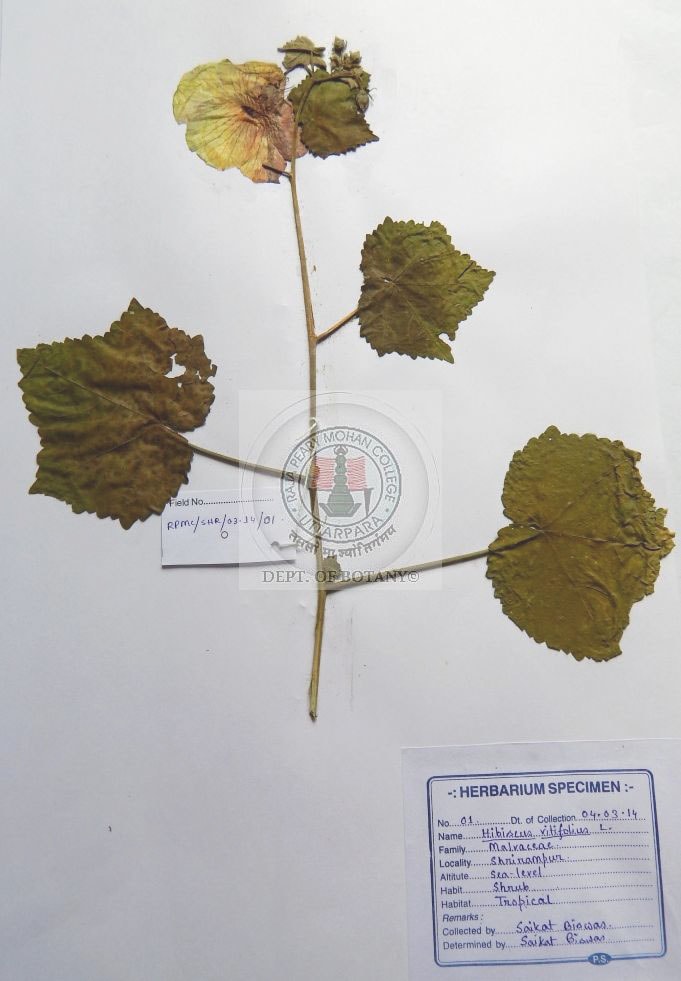
|
| 50 |
Jatropha gossypifolia L. |
Euphorbiaceae |
Perennial upright, deciduous shrub, can grow up to 1-4 m. sparsely branched, sticky, yellow, translucent sap; older stems are thick succulent, younger stems are purple and surface is pubescent; leaves light green, alternate, palmately divided into 3 - 5 lobes, measuring about 4.5 - 10 cm long and 5 - 13 cm wide, purple in young sticky hairy; flowers small, red in terminal corymbose cyme, maroon 5-petaled flowers in terminal panicles, peduncle of each cluster measuring about 10 - 15 cm long, separate male and female flowers in each cluster, male flowers have 8 - 12 yellow stamens while the middle flower of each branch of the cluster is female; tricarpellery; fruits-oval capsule containing three dark brown seeds
|
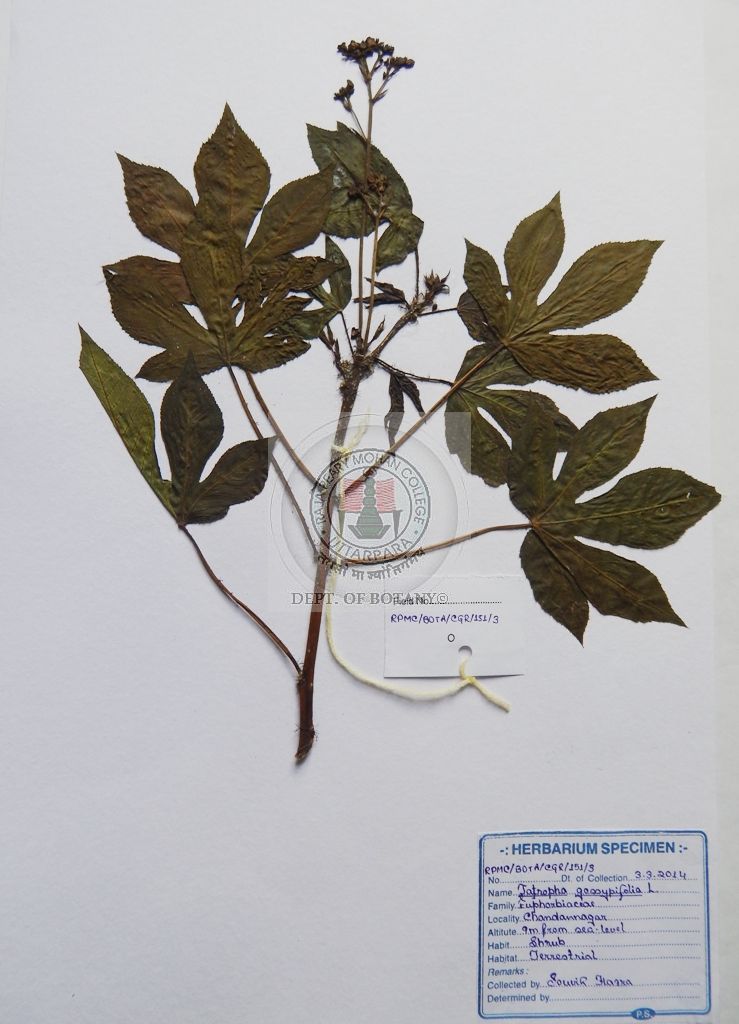
|
| 51 |
Lippia geminata Kunth |
Verbenaceae |
Aromatic, erect, sparsely branched shrub growing up to 2 m; stem branched, hairy; leaves simple, fragrant, decussate-opposite or ternate, deciduous, serrate at margin; inflorescence spicate or capitate, solitary or fascicled in leaf axils; flowers small, sessile, borne singly in the axils of bracts, often more or less 4-ranked; calyx persistent, membranous, gamosepalous, ovoid-campanulate; corolla connate, hypocrateriform or infundibular, 4-lobed, zygomorphic; tube cylindric, straight, slightly exserted from calyx; lobes oblique, spreading, somewhat 2-lipped, the anterior lip larger than the posterior; stamens 4, didynamous, inserted at about the middle of the corolla-tube (epipetalous); anthers ovate, unappendaged, the cells parallel; ovary 2-locular, with 1 ovule/locule in axile placentation; style often short with oblique or sublateral stigma; fruit dry, ovoid, surrounded by the fruiting-calyx and sometimes partially adnate to it, dividing into 2 mericarps or "nutlets" at maturity; pericarp papery or hard; seeds exalbuminous
|
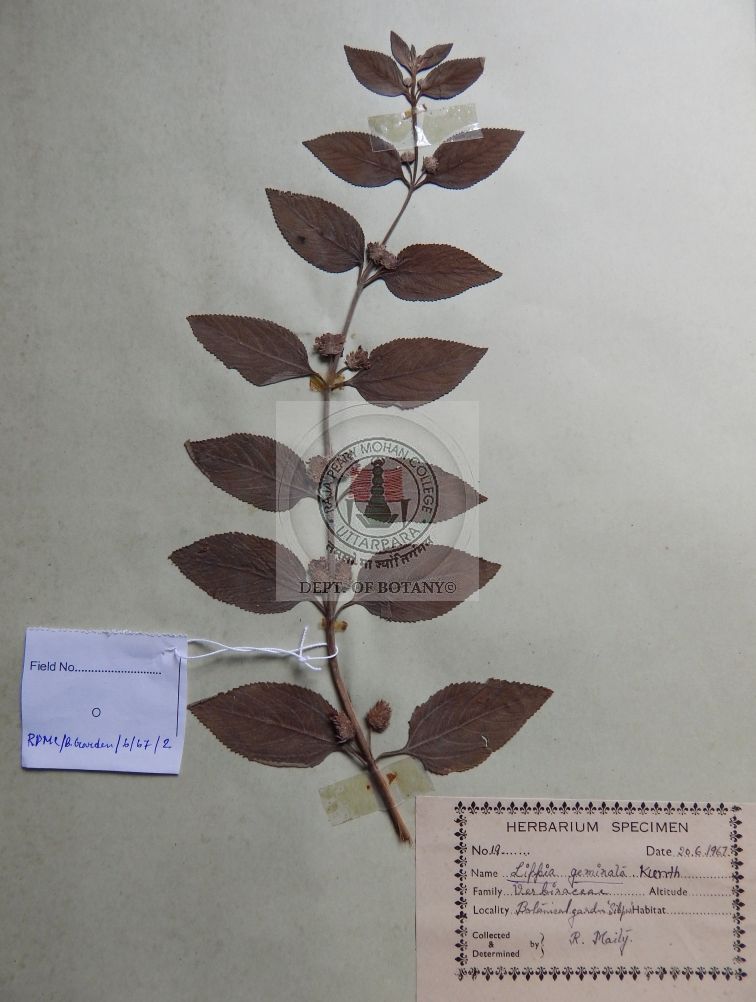
|
| 52 |
Melilotus officinalis (L.) Medik. |
Fabaceae (Leguminosae) |
Annual, erect, 3-8’ tall, lanky, branched; stems light green, round or slightly terete (i.e., furrowed on all sides), glabrous; leaves compound, alternate, trifoliate, sparsely distributed along the stems; leaflets greyish green, up to 1” long and 1/3” across, dentate along the upper margins, and oblong or oblong-ovate with a pair of small narrow stipules at the base of each trifoliate leaf’s petiole. The middle leaflet has a conspicuous petiole of its own (i.e, a petiolule), while the lateral leaflets are nearly sessile; flowers white arranged in narrow racemes with a tendency to hang downward from the central stalk of the raceme, and they sometimes appear on only 1 or 2 sides; petals white; flower tubular at the base, becomes broader toward the outer edges of the petals-consist of a standard, a keel, and a 2 lateral aloe or wings; fruit-a pod
|
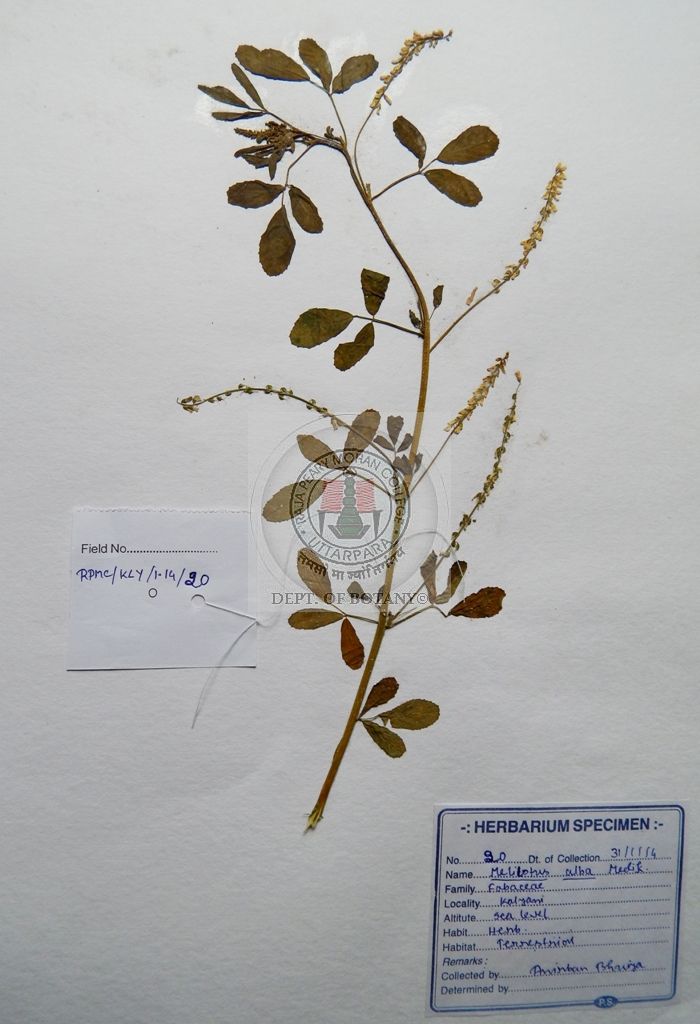
|
| 53 |
Mimosa pudica L. |
Fabaceae (Leguminosae) |
A creeping, annual or perennial, diffuse prickly undershrub; stems cylindrical; sparsely prickly, covered with long, weak bristles longitudinally grooved, external surface light brown, internal surface grey, bark fibrous; leaves digitately compound with one or two pairs of sessile, hairy pinnae, alternate, petiolate, stipulate, linear lanceolate; leaflets 10–20 pairs, sessile, obliquely narrow or linear oblong; obliquely rounded at base, acute, nearly glabrous; yellowish green; flowers pink arranged in globose head, peduncles prickly; calyx very small; corolla pink, lobes 4, ovate oblong; stamens 4, much exerted; ovary sessile; ovules numerous; fruits- lomentum, simple, dry with indehisced segments and persistent sutures having —two to five seeds with yellowish spreading bristle at sutures, glabrous, and straw colored.
|
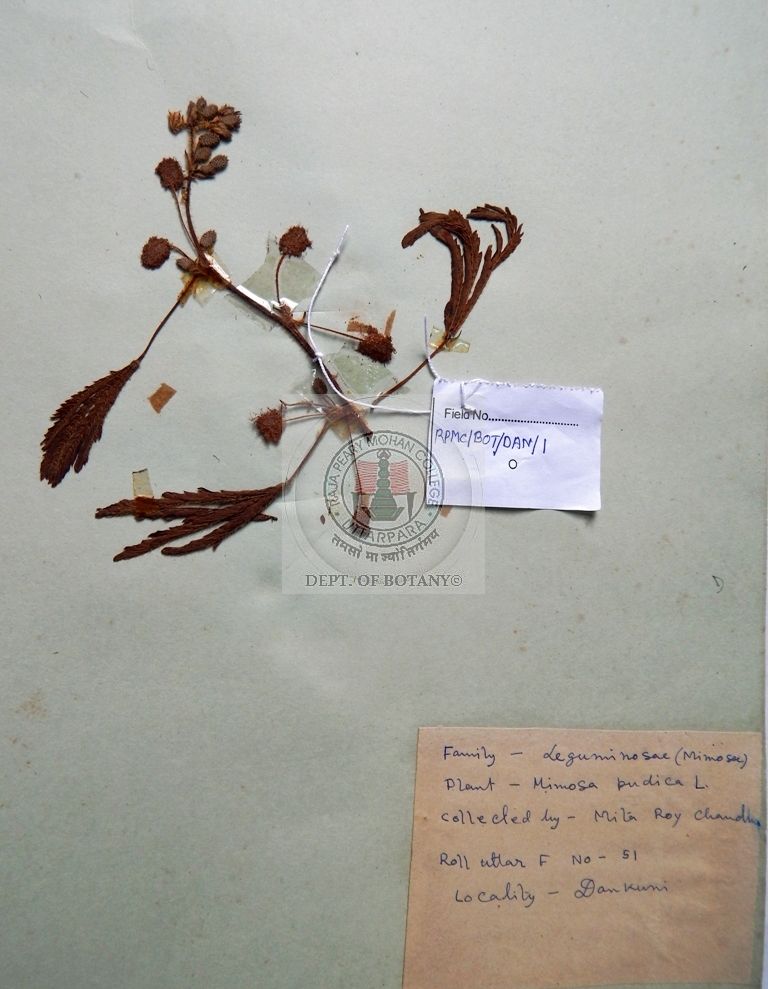
|
| 54 |
Panicum flavidum Retz. |
Poaceae (Gramineae) |
perennial grass, spikes separated by 2-4 times their length, and spikelets (especially in fruit) spherical. Stems (culms) are tufted, slightly compressed. Leaf sheaths are strongly keeled, smooth. Leaves are linear-lanceshaped, flat or folded. Rachis slightly winged, prolonged into a point. Spikelets are plumply ovate, gibbous, milk-white or purplish. Lower glume is broadly ovate; upper glume, 7-veined; lower lemma as long as spikelet, 5-veined; upper lemma bony, granulate.
|
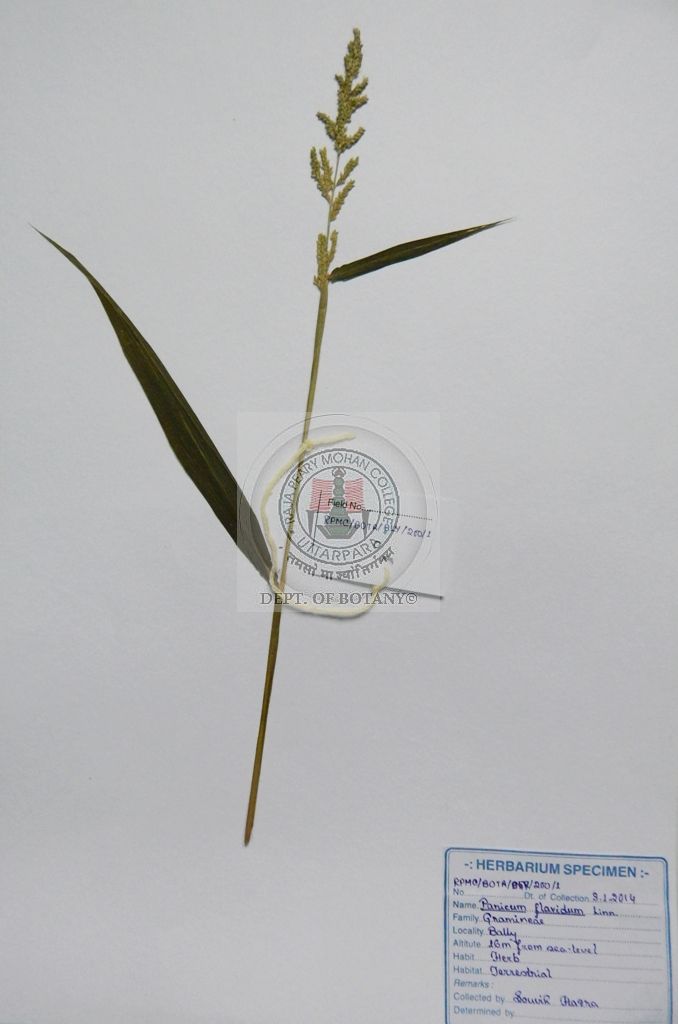
|
| 55 |
Panicum montanum Roxb. |
Poaceae (Gramineae) |
Perennial herb with smooth stem, sparingly branched; leaves thin, glabrous or pilose; Leaf-blade margins scabrous; ciliate; inflorescence a panicle; culms decumbent, or rambling; flowers in spikelet; spikelet sterete, glabrous or faintly hairy, spikelets solitary. Fertile spikelets pedicelled. Second glume fugacious; membranous-ciliate ligules, open panicles with spikelets on long pedicels, the spikelets with upper glume and lower lemma 7–13-nerved, and upper anthecium indurate, with compound papillae at the apex of the upper palea; Anthers 3; 1.6–1.9 mm long. fruits caryopsis with smooth seeds, brown with three strips
|
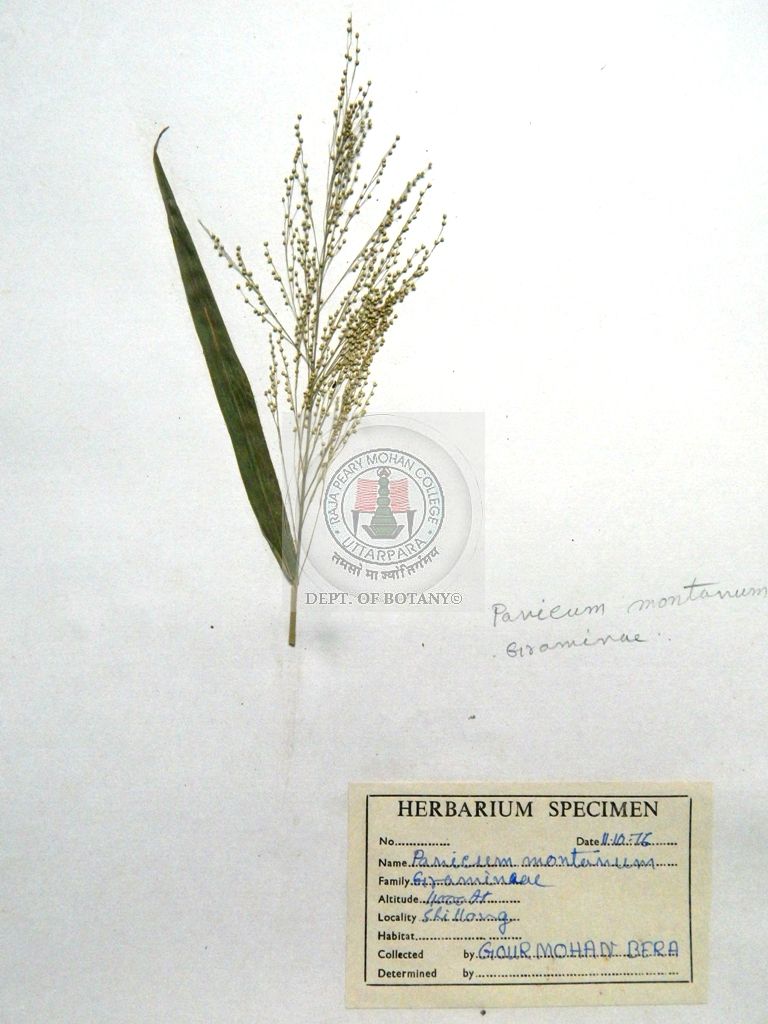
|
| 56 |
Polygonum orientale L. |
Polygonaceae |
Annual erect, herb; leaves slightly hairty, ovate, alternate, stipulate; stipules ochreate; flowers white to pink, arranged in cylindrical raceme, laxly panicled, 8 to 13 centimeters long; perianth of each tiny flower consists of four or five segments, united near its green base and white or pink at the edges. There are six stamens, three fused carpels and three styles. Fruit-a dark brown oval, flattened nut, placentation basal.
|
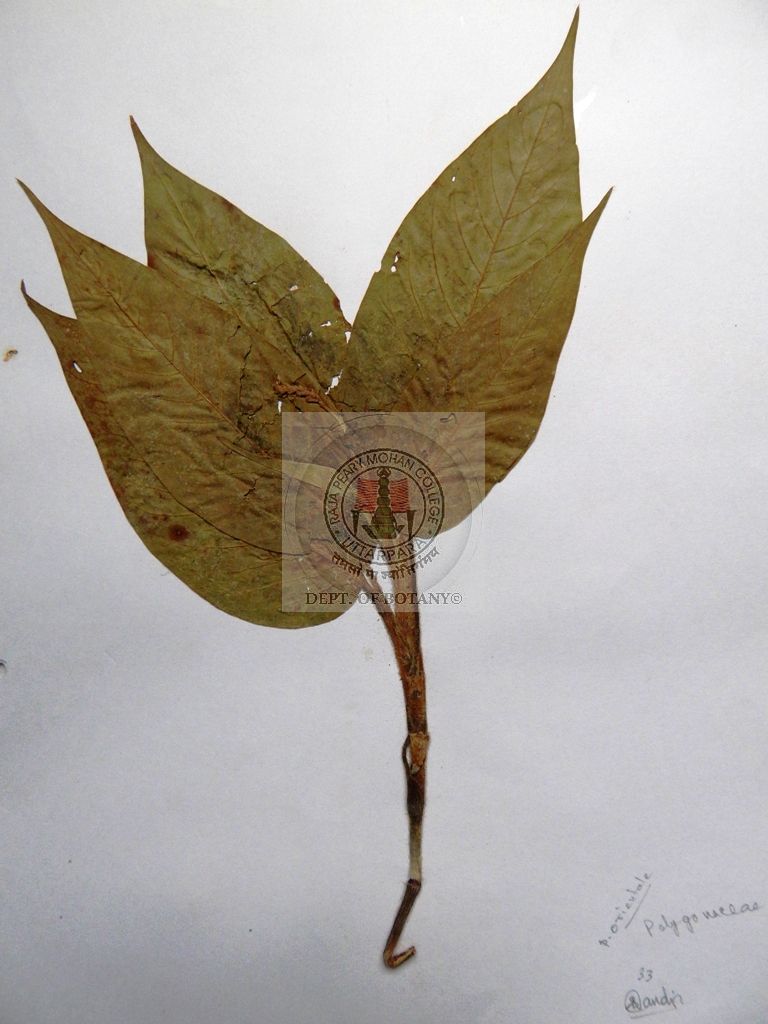
|
| 57 |
Ricinus communis L. |
Euphorbiaceae |
A fast-growing shrub or small tree; shoots usually glaucous, variously green or red; stem and branches with conspicuous nodes and ringlike scars of the bracts; leaves spirally arranged, dark green when old; stipules united to a sheathing bud, deciduous; petiole round; blade peltate, membranous, palmate with 5-11 acuminate, serrate lobes; Flowers shortly pedicelled in lateral cymes; panicles erect, terminal, later somewhat lateral by overtopping, up to 40 cm long, usually glaucous, with unisexual flowers, male flowers towards the base, female ones towards the top. 3-5 acute calyx lobes; corolla absent; male flowers with many stamens in branched bundles; female flowers with early caducous sepals; ovary superior with three 1-ovuled cells, usually soft spiny; styles 3, red or green, 2-cleft; fruits ellipsoid to subglobose, 15-25 mm long, brown, spiny or smooth; seeds ellipsoid, compressed, with a brittle, mottled, shining seedcoat and with a caruncle at the base; endosperm copious, white; cotyledons thin.
|
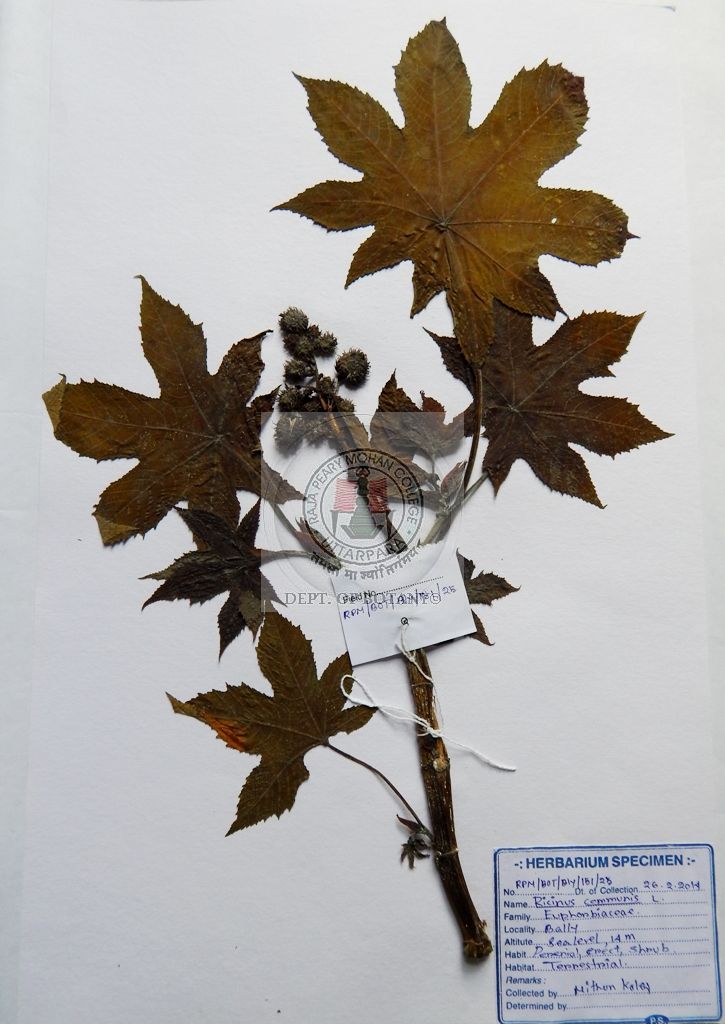
|
| 58 |
Ruellia tuberosa L. |
Acanthaceae |
Herb with tuberous fusiform roots, opposite leaves, winged petioles, stem 4-angled, flowers violet; Cymes dichotomous, few-flowered, bracts narrow; calyx lobes linear, 12-20 mm long, hispid; corolla tube abruptly expanded above, 4-6 cm long, purple, lobes suborbicular; stamens included in throat, strongly didynamous, anthers not overlapping; filaments fused for 1–2 mm at base, free parts 2–3 and 6–7 mm long; anthers 3–4 mm long; capsule linear, glabrous
|
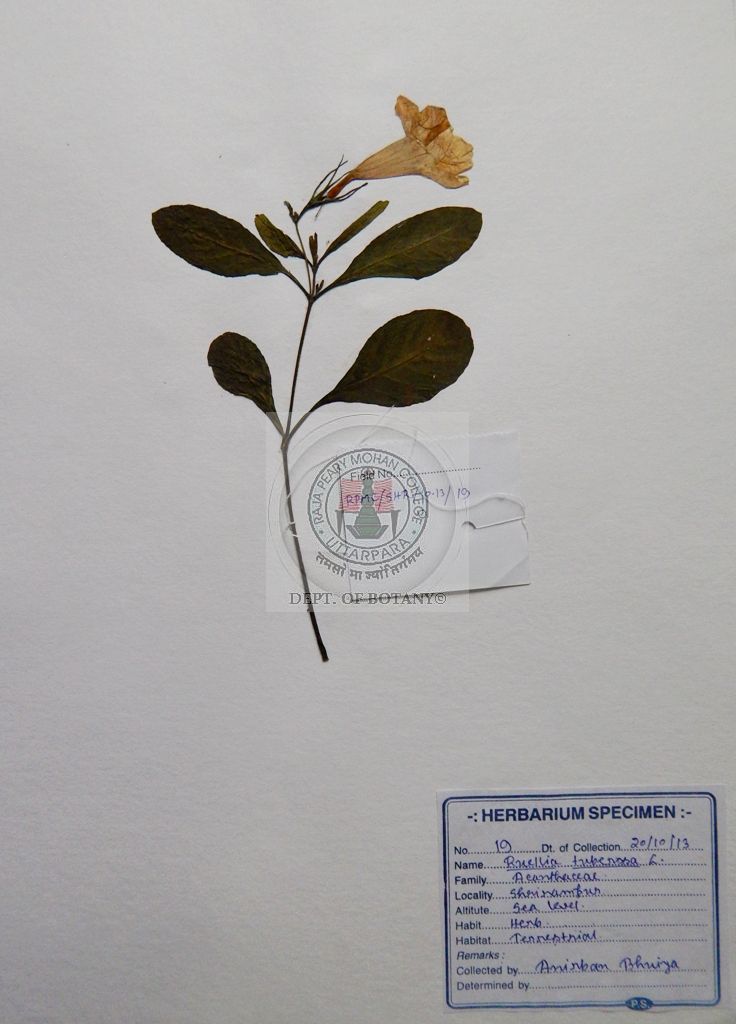
|
| 59 |
Solanum nigrum L. |
Solanaceae |
Perrennial undershrub; stem branches lax, ovate to lanceolate leaves, wavy margins; flowers white, small, arranged in extraaxillary raceme; calyx connate below; corolla white, connate below; stamens 5, alternipetalous; styles hairy, ovary obliquely placed; fruit with persistent calyx, berry
|
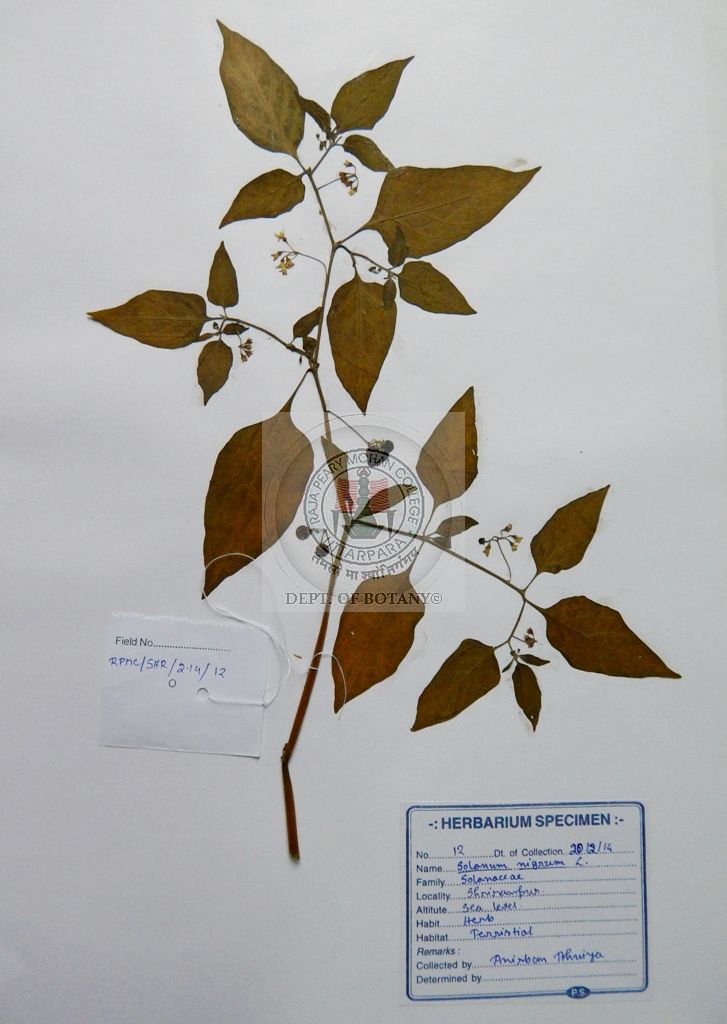
|
| 60 |
Solanum xanthocarpum Schrad. & J.C.Wendl. |
|
A very prickly, bright green, semi perennial, upto 1.5 m grown shrub, highly branched and with bluish-purple flower; stem herbaceous; 8-10 mm thick and variable length with prominent nodes and internodes and prickly nature; green and branches covered with hairs and with prominent furrows (young); when mature glabrous; yellowish green, smooth surface with a thin layer of bark and prominent wood (dry); centre with a large, distinct pith and mature dry stem with hollow pith; leaves exstipulate, petiolate, elliptic or ovate-oblong ,sub-pinnatifid or sinuate, subacute, hairy, green, midrib and veins with sharp prickles; flowers bright blue or bluish purple in colour; ebracteate pedicellate, bisexual, complete, actinomorphic, pentamerous; calyx persistent, gamosepalous, tube globose, short, linear-lanceolate, acute, hairy; corolla gamopetalous, deltoid lobes, acute, hairy, deep purple-blue coloured, stamens 5, epipetalous, basifixed, filament short 1-1.5 mm long; anther, oblong lanceolate; ovary superior, ovoid; bilocular, with many ovules/ chamber in axile placentation, glabrous; fruit globular, berry, with persistent calyx at base, unripe and ripe fruits variegated with green and white strips and yellow and white shades respectively; seeds flat, circular, glabrous.
|
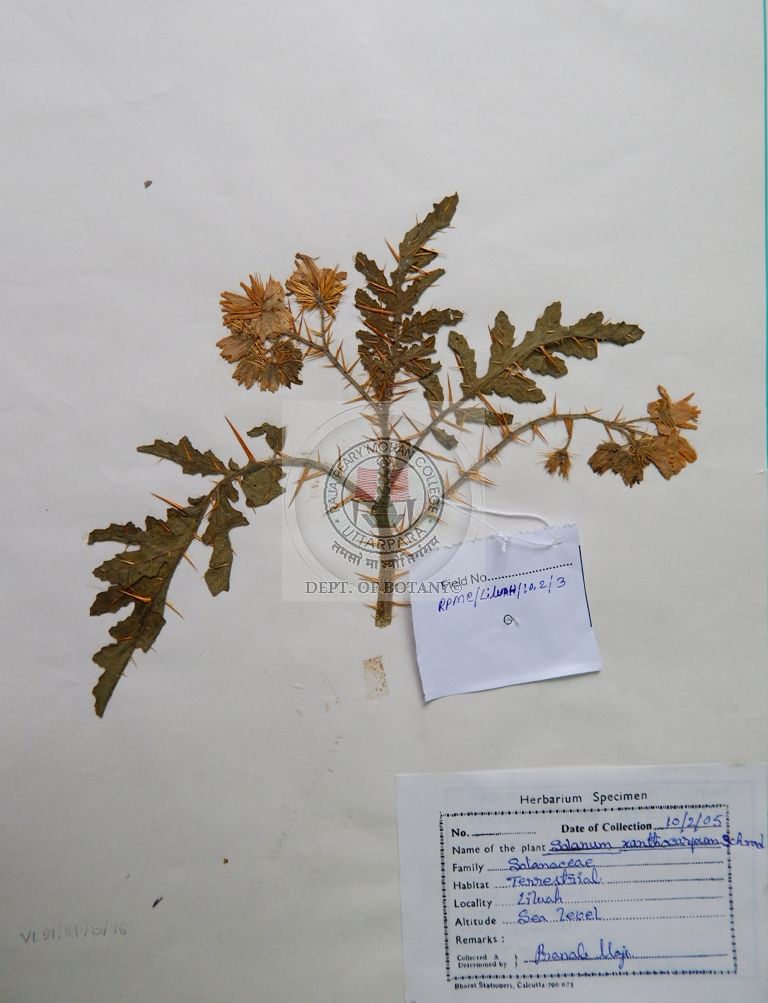
|
| 61 |
Spilanthes acmella (L.) L. |
Asteraceae (Compositae) |
Annual erect or ascending stout herb, leaves opposite, petiolate, broadly ovate, narrow at base, acute, axillary and terminal panicles, ray florets few, disc florets companulate, Achenes dorsally compressed.
|
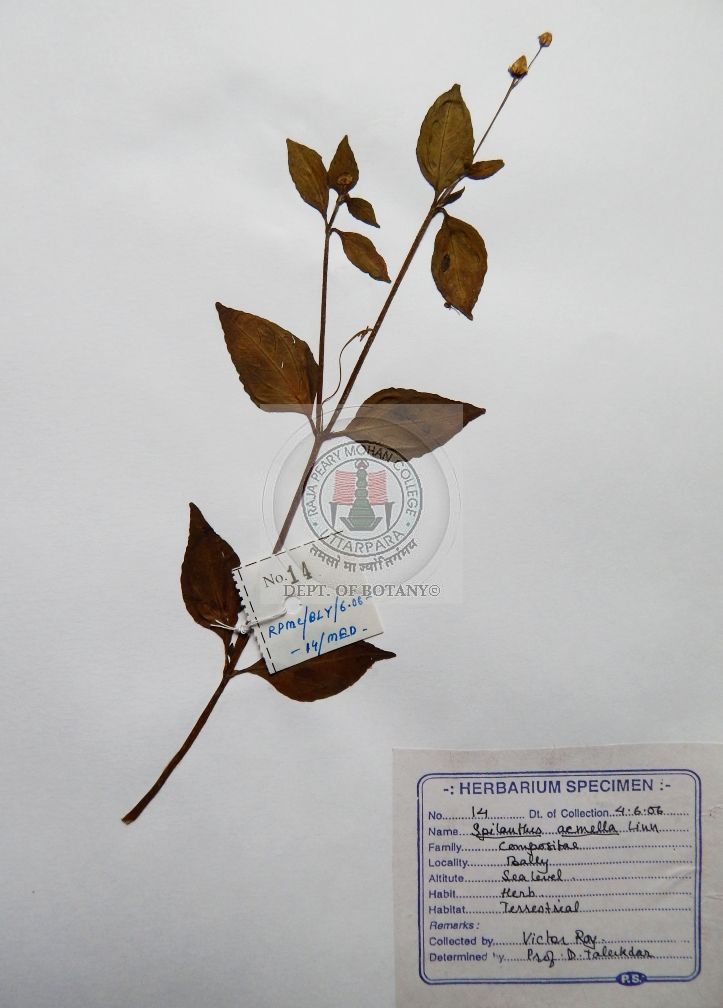
|
| 62 |
Telanthera philoxeroides Moq. |
Amarathaceae |
An annual, branched, herb; stem ascending from a creeping base, branched; young stem and leaf axil white hairy; old ones glabrous; leaf blade oblong, oblong-obovate, or ovate-lanceolate, glabrous or ciliate, adaxially muricate, base attenuate, margin entire, apex acute or obtuse, with a mucro. Heads with a peduncle, solitary at leaf axil, globose; bracts and bracteoles white, 1-veined, apex acuminate; bracts ovate; bracteoles lanceolate; tepals white, shiny, oblong glabrous, apex acute; filaments connate into a cup at base; pseudostaminodes oblong-linear, as long as stamens. Ovary obovoid, compressed, with short stalk.
|
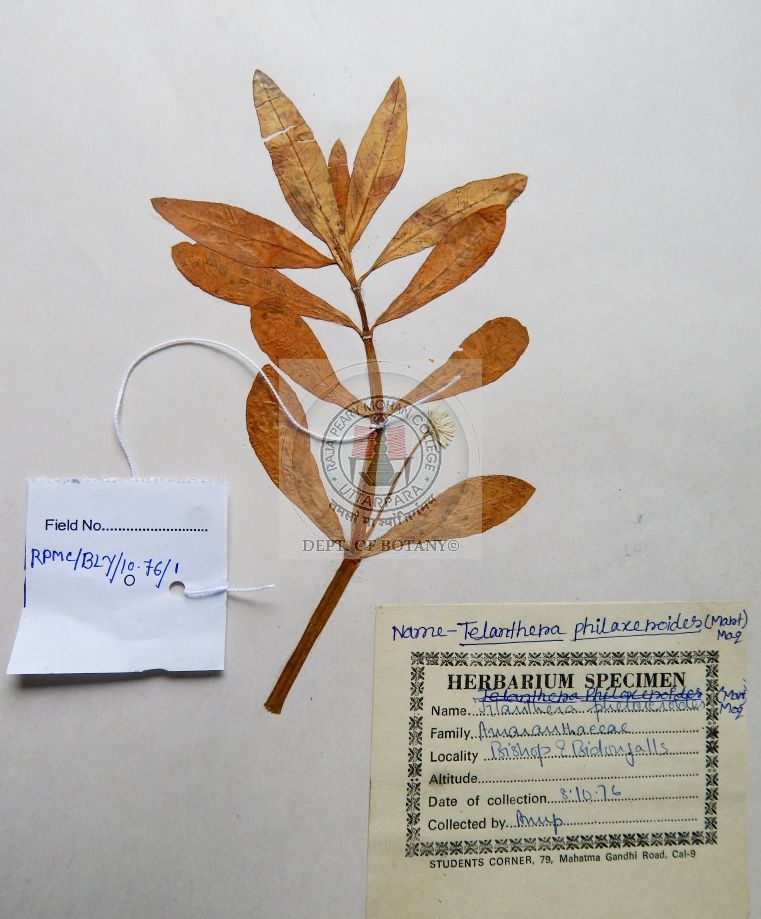
|
| 63 |
Trifolium pratense L. |
Fabaceae (Leguminosae) |
Perennial herb; stem ascending, erect, branched; leaves alternate, stipulate, compound, often in three leaflets, leaflets lanceolate-elliptic, entire to finely toothed at margins often with white botches, stipule bristled; flowers irregular, calyx 5-lobed; corolla 5, violet-red, vexillary in aestivation, stamens 10, monocarlellary gynoecium; fruits pod
|
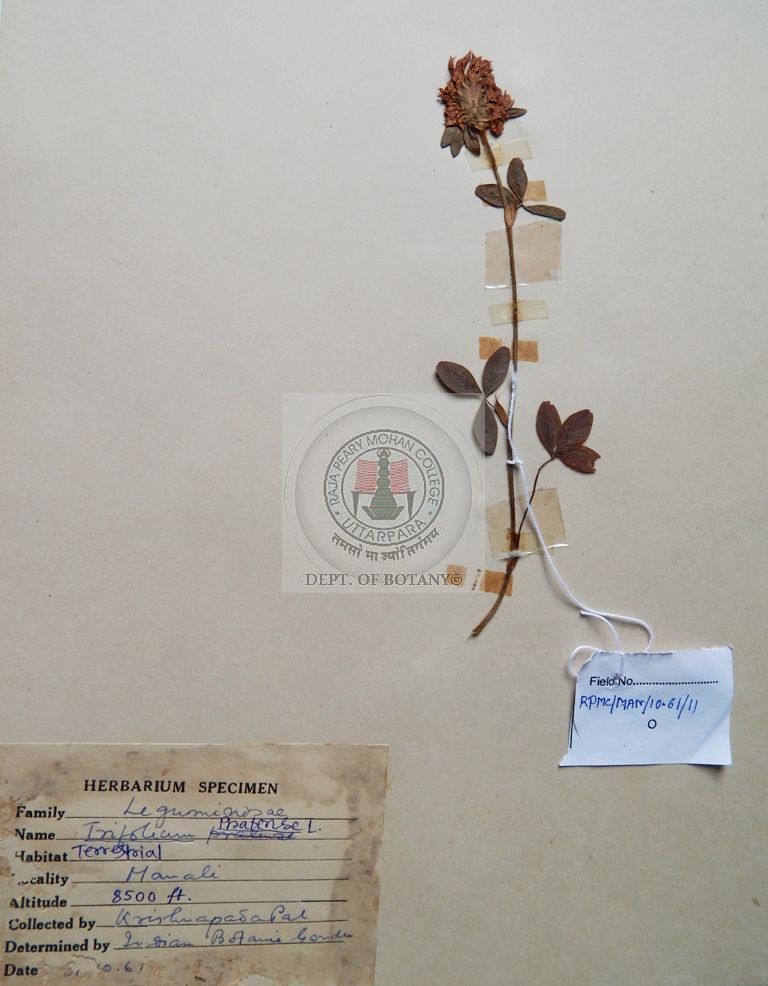
|
| 64 |
Urena lobata L. |
Malvaceae |
A fast-growing, spreading, branched shrub, erect, woody perennial; stems and leaves star-shaped (stellate) hairy; often many branched at the base; leaves simple, alternate, with the upper surface rough and the lower surface grayish, broadly ovate, often with 3-5 shallow, angular lobes at apex, up to 10 cm long; finely toothed at margins, heart shaped at bases; stipulate; flowers small, showy, hibiscus-like, solitary on short stalks in leaf axils, subtended by 5 basally united (involucral) bracts up to 0.7 cm; calyx 5-lobed, hairy; 5 petals, rose or pink, darker at the base, rounded, up to 1.5 cm long; stamens fused into an obvious pink column beneath a 5-lobed style; fruits capsule-small, barbed, spiny
|
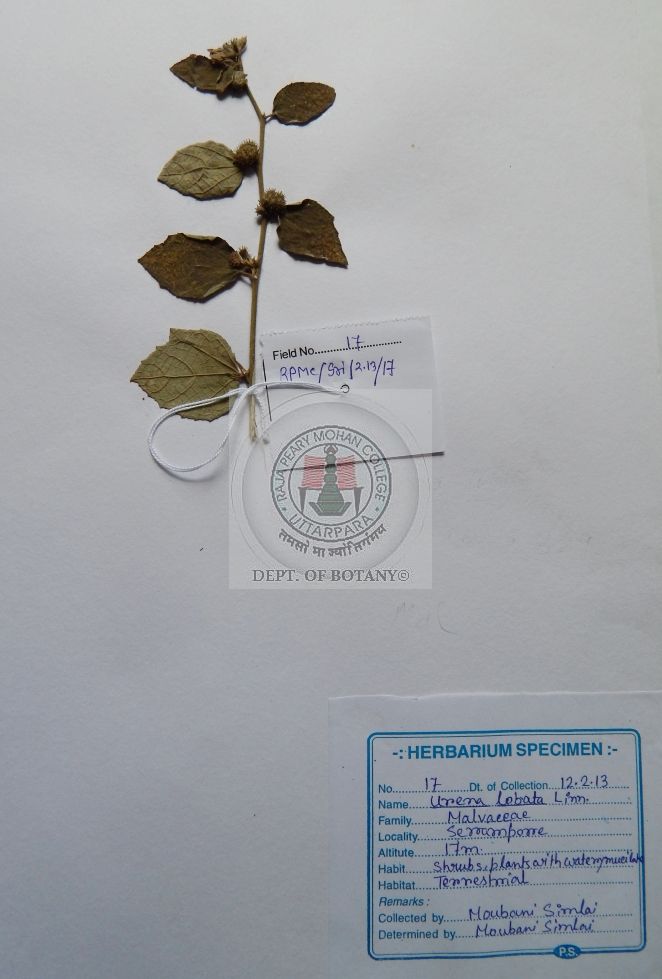
|
| 65 |
Vicia sativa L. |
Fabaceae (Leguminosae) |
An annual scrambling and climbing herb; leaves compound, alternate, stipulate; stipule toothed margins, dark-spotted; leaflets obovate-lanceolate-linear, 1-7 pairs, terminal leaflets modified into a tendril, notched at tip, entire at margins; corolla irregular, purple-red, petals 5 in typical vexillary aestivation, stamens 10-dialdelphous, filaments with fused bases; gynoecium monocarpellary; inflorescence 1-2-flowered raceme; fruits legume
|
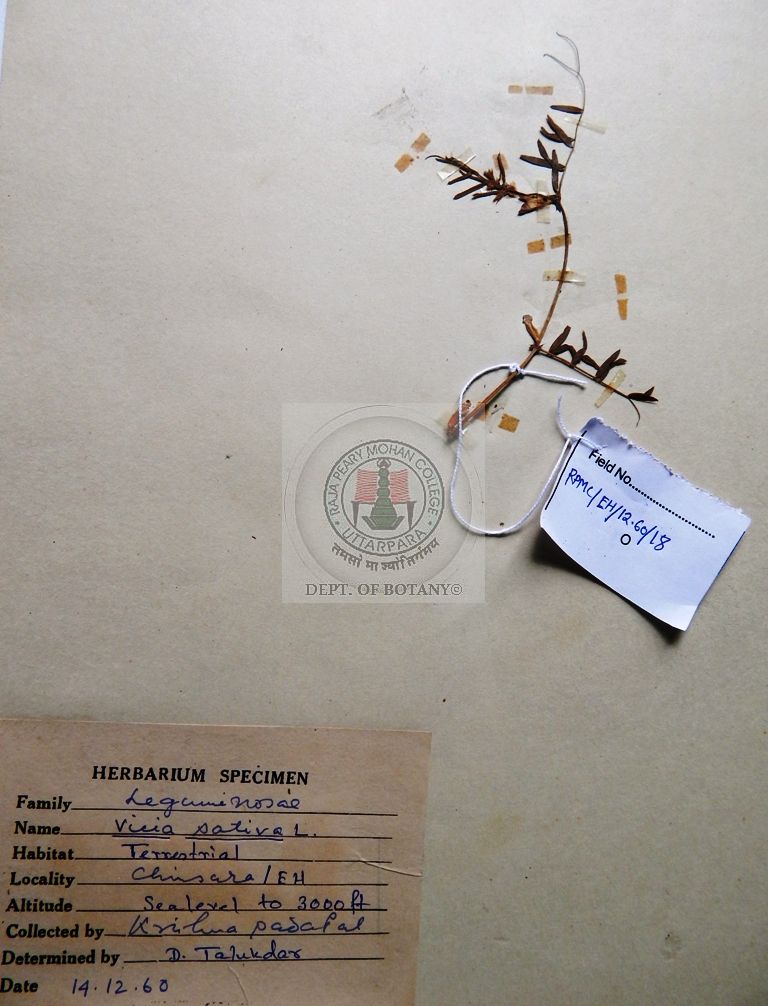
|